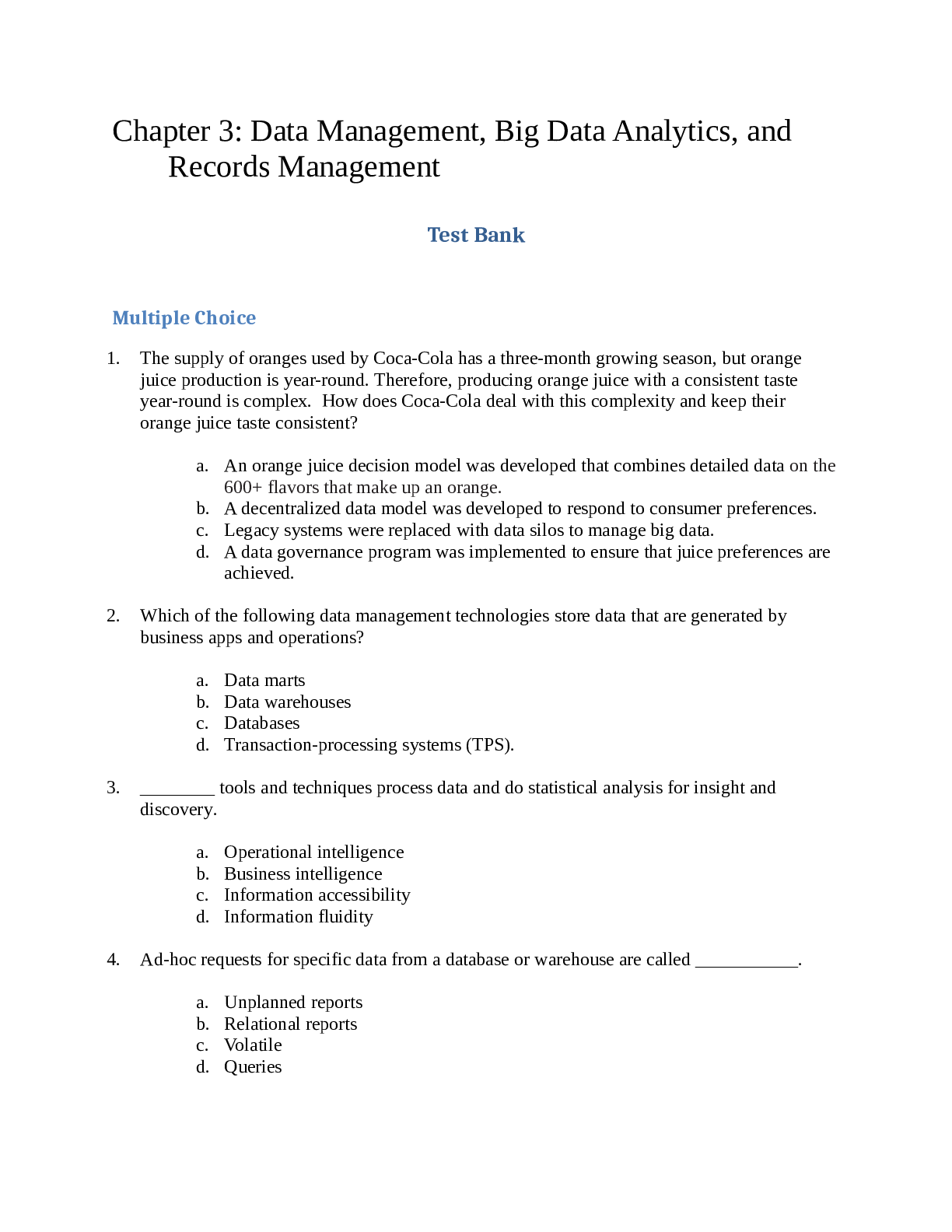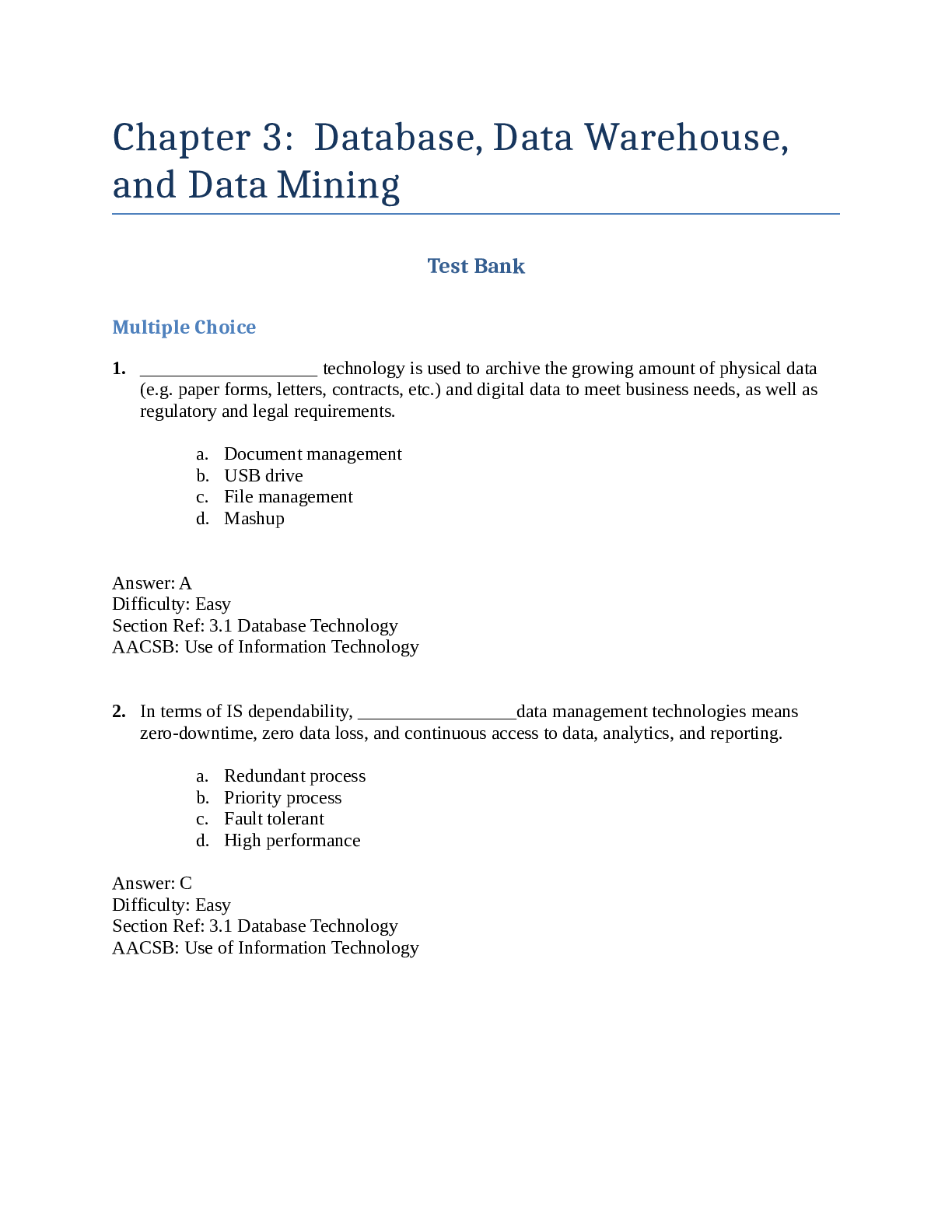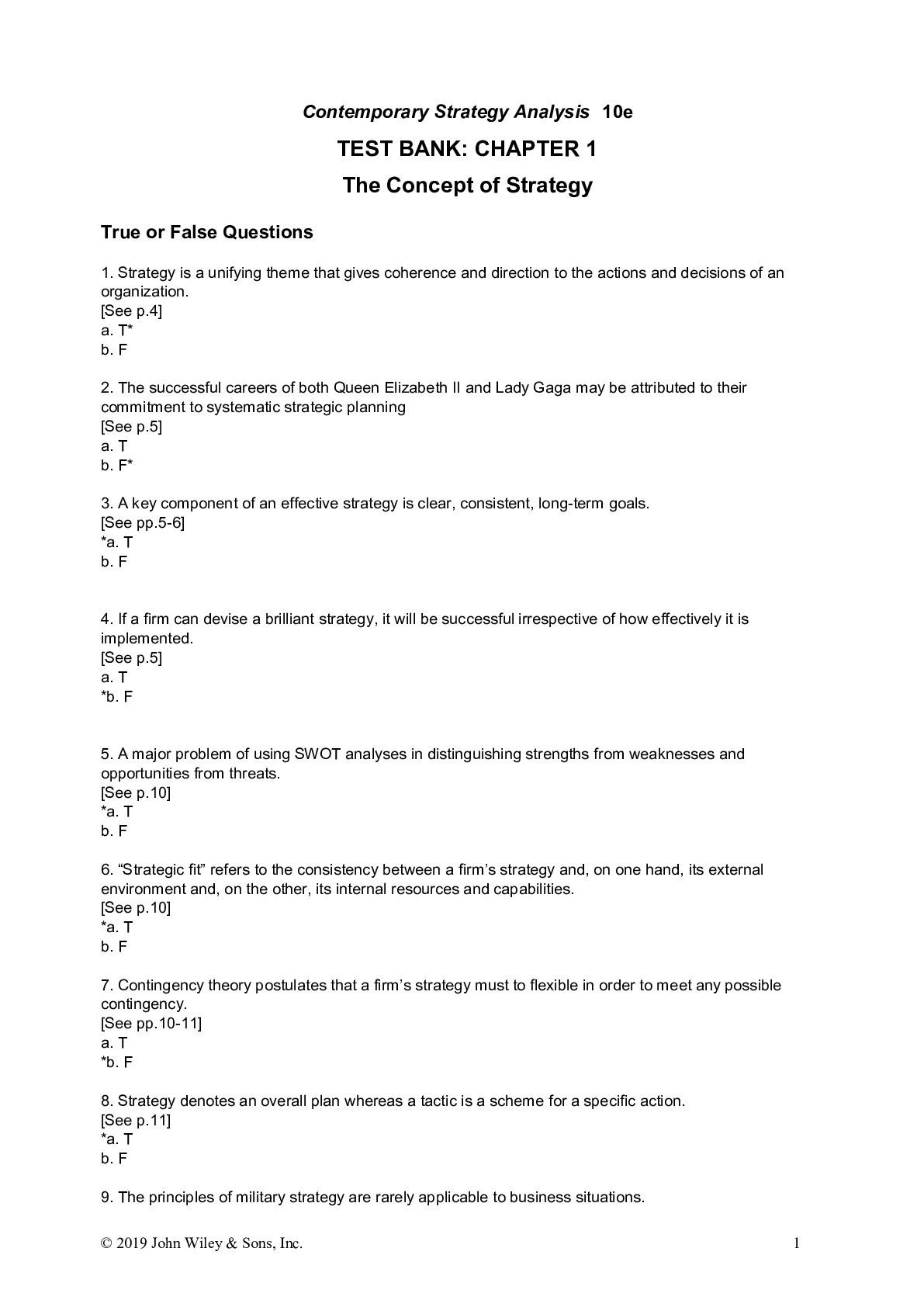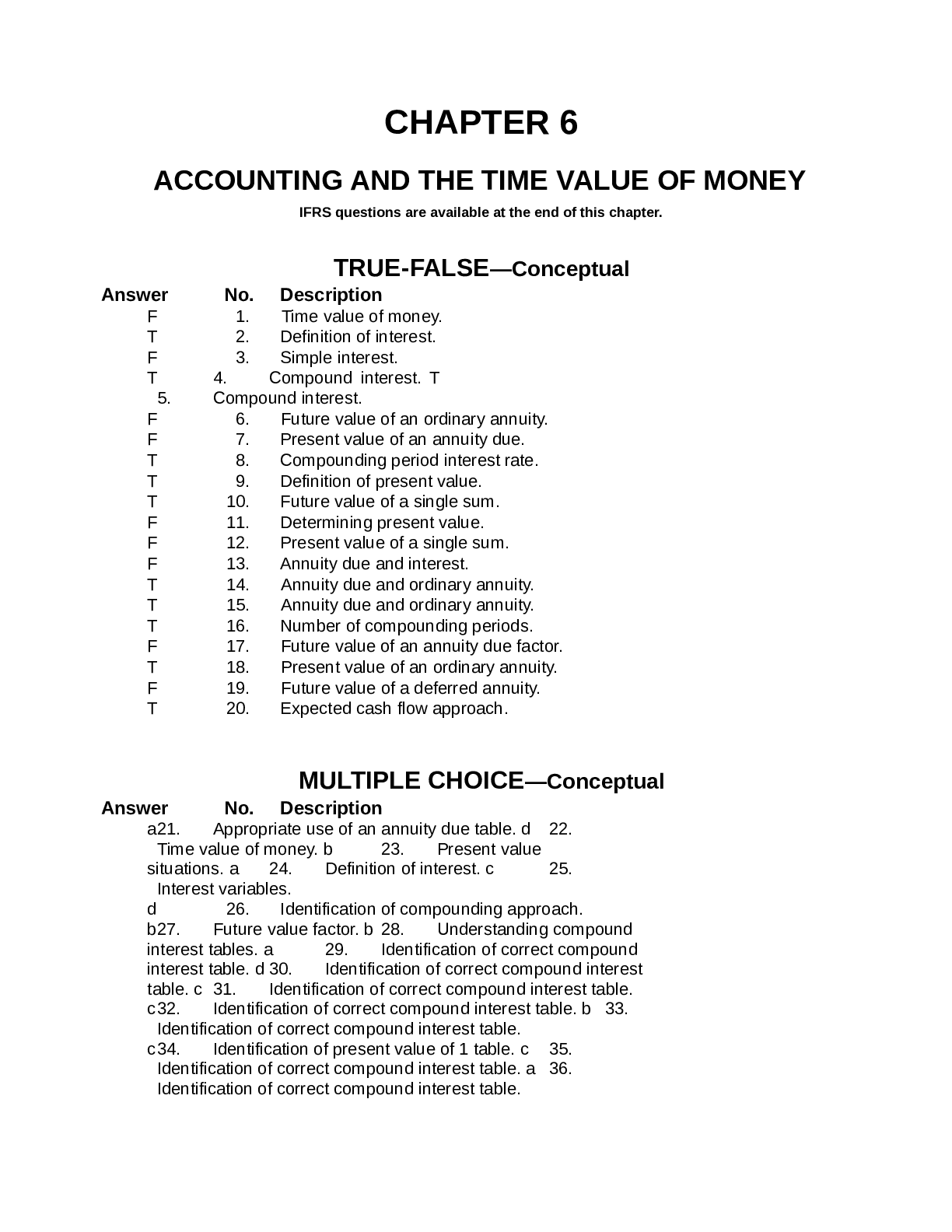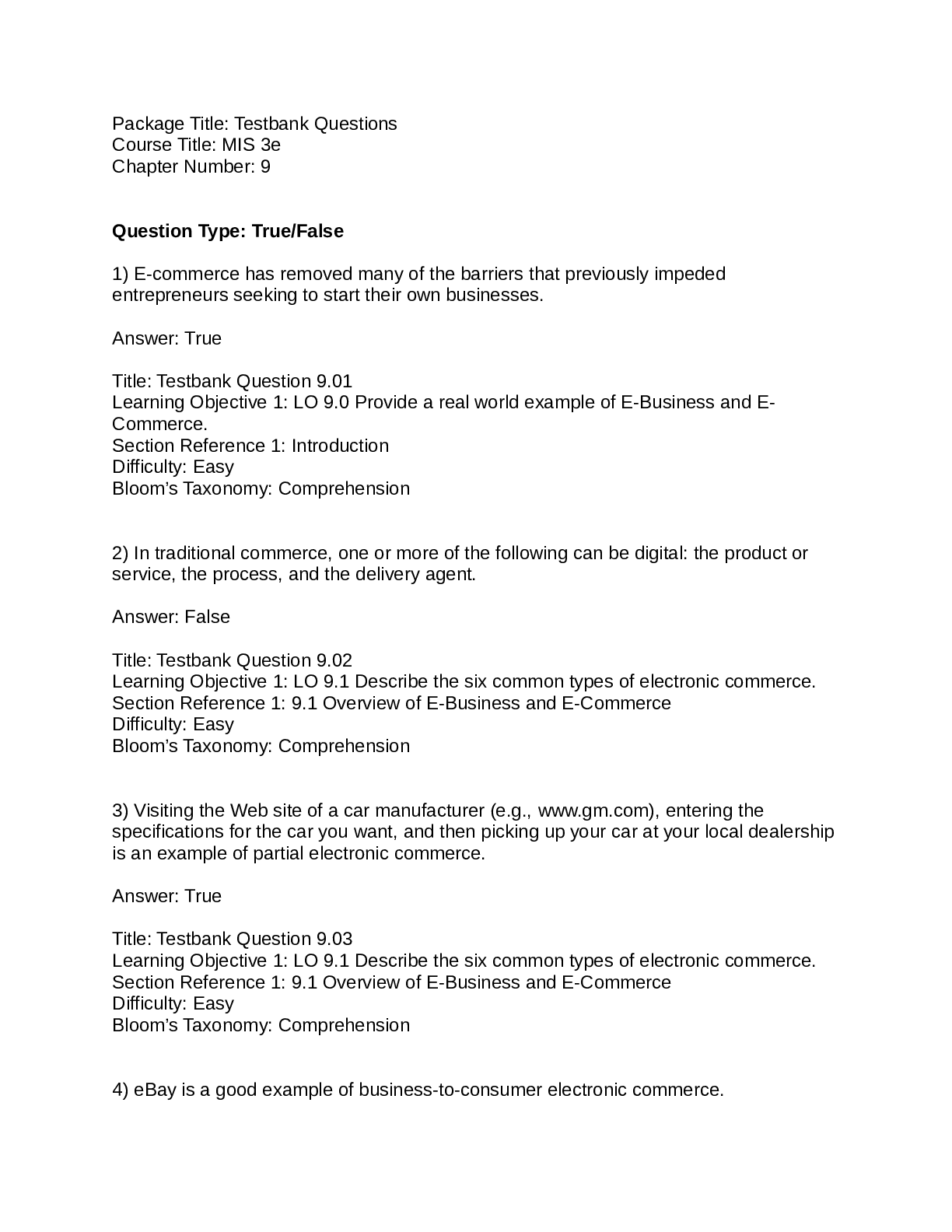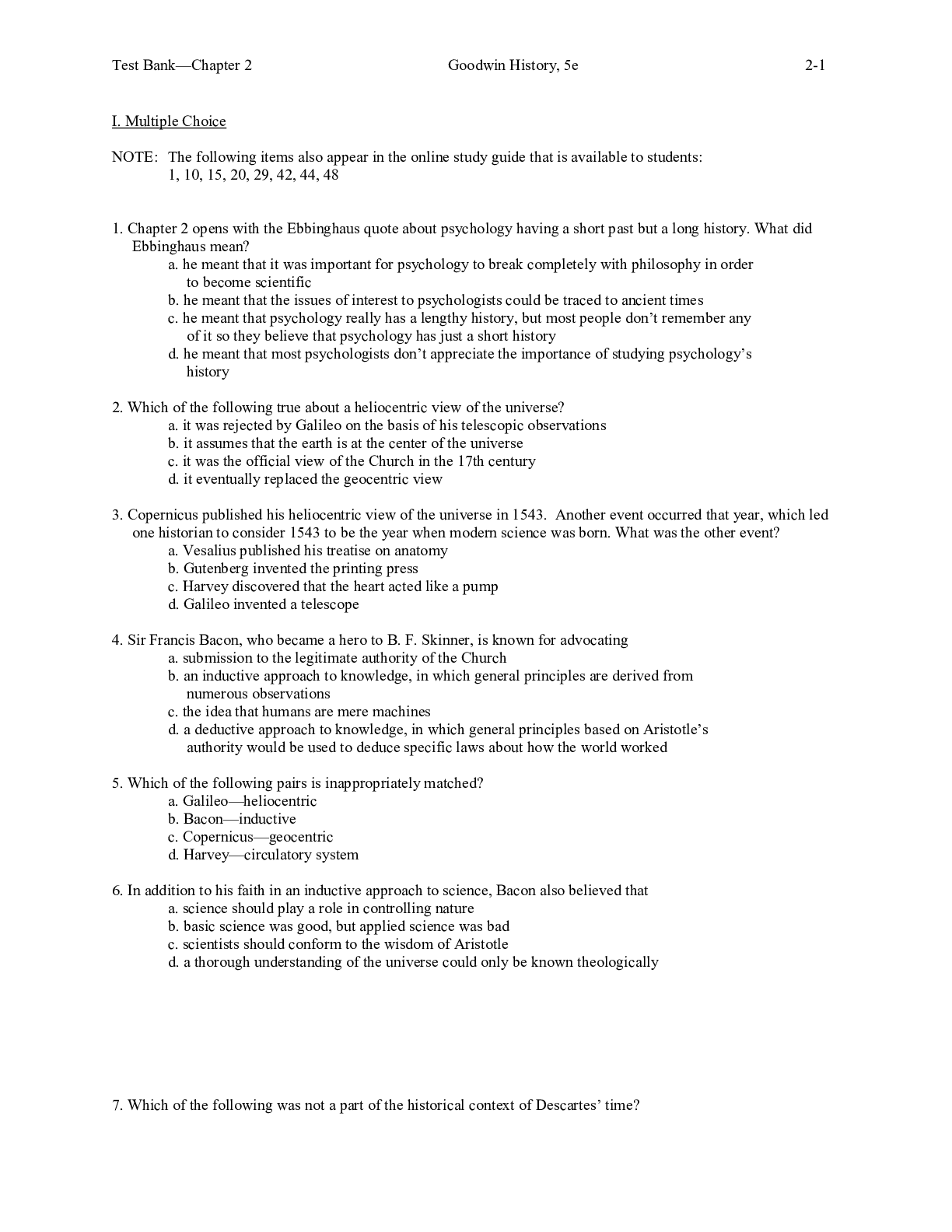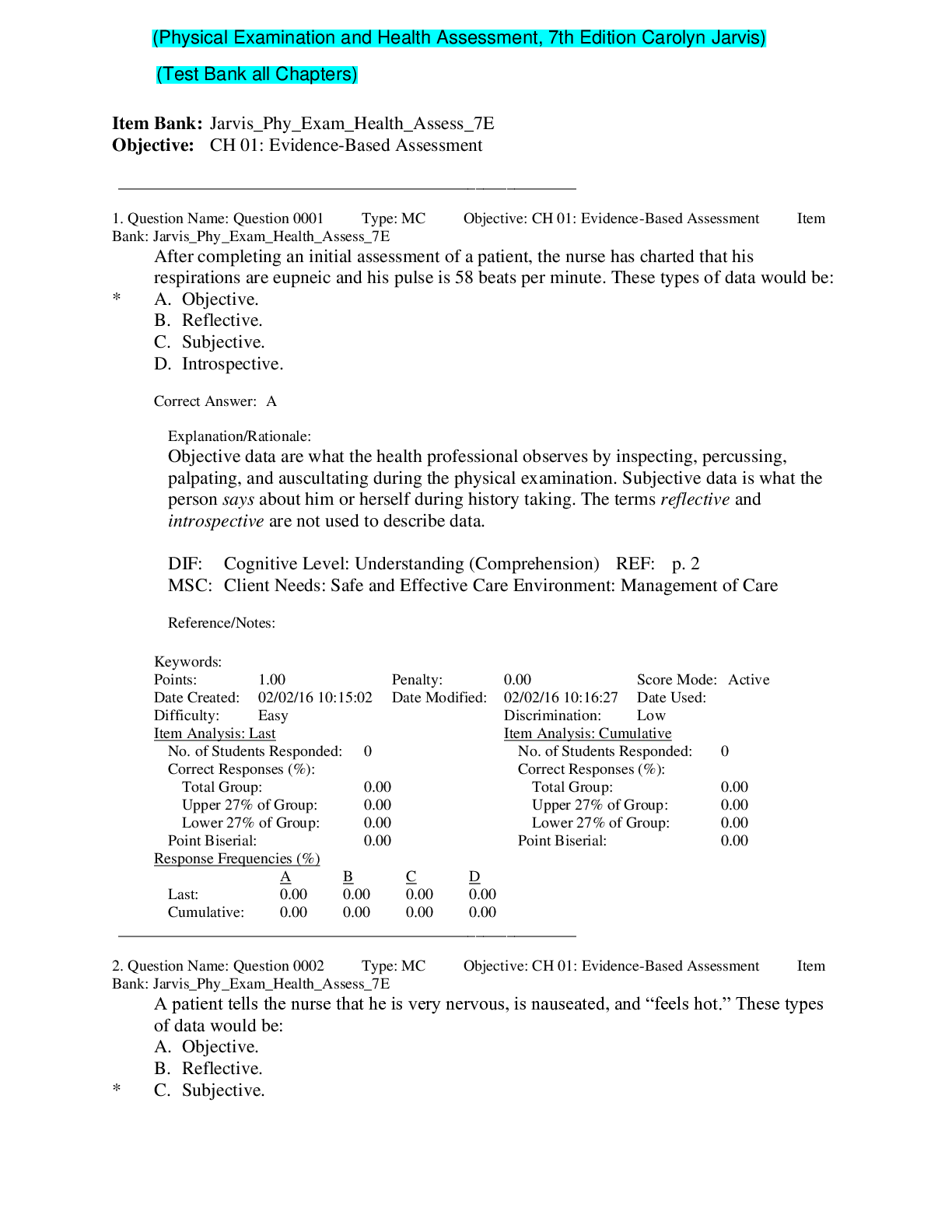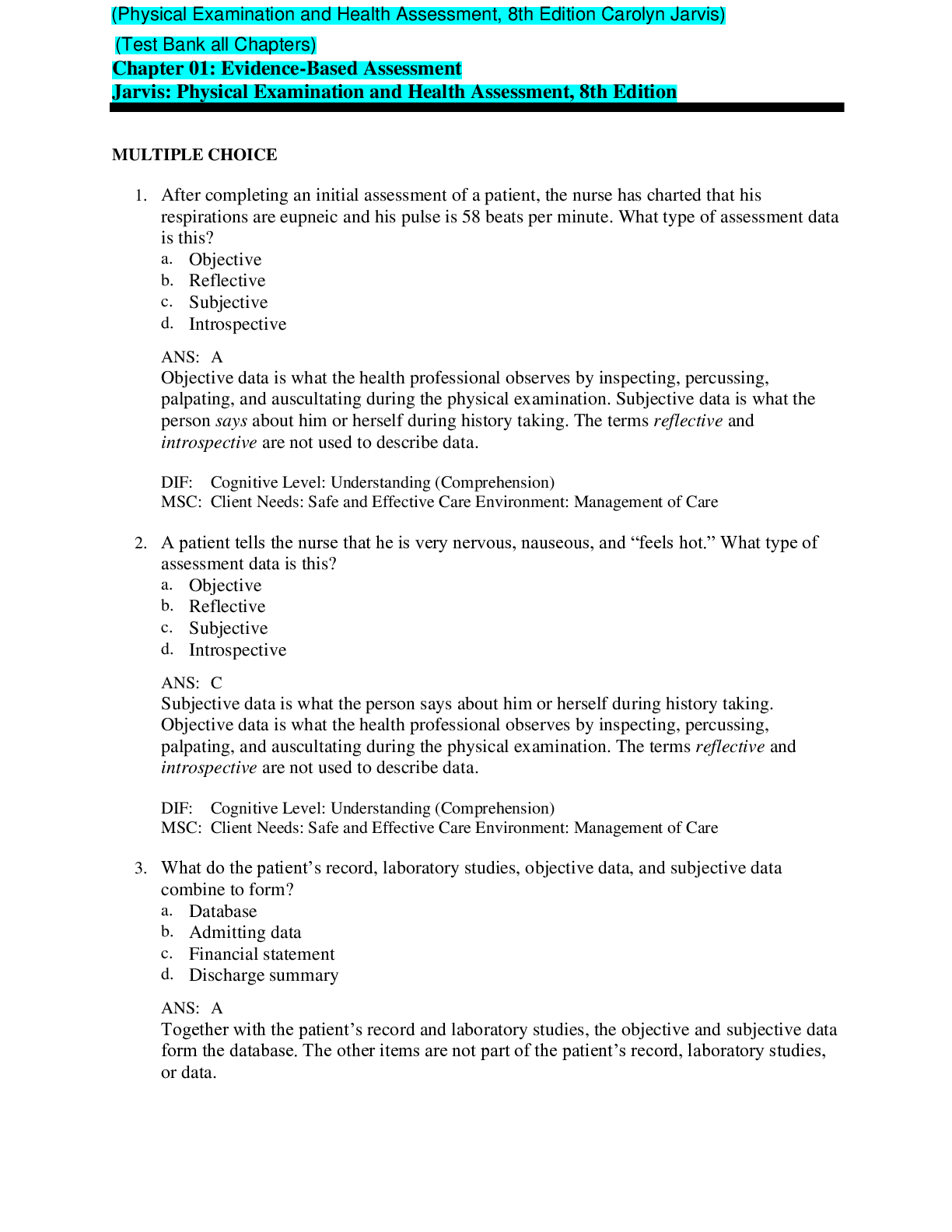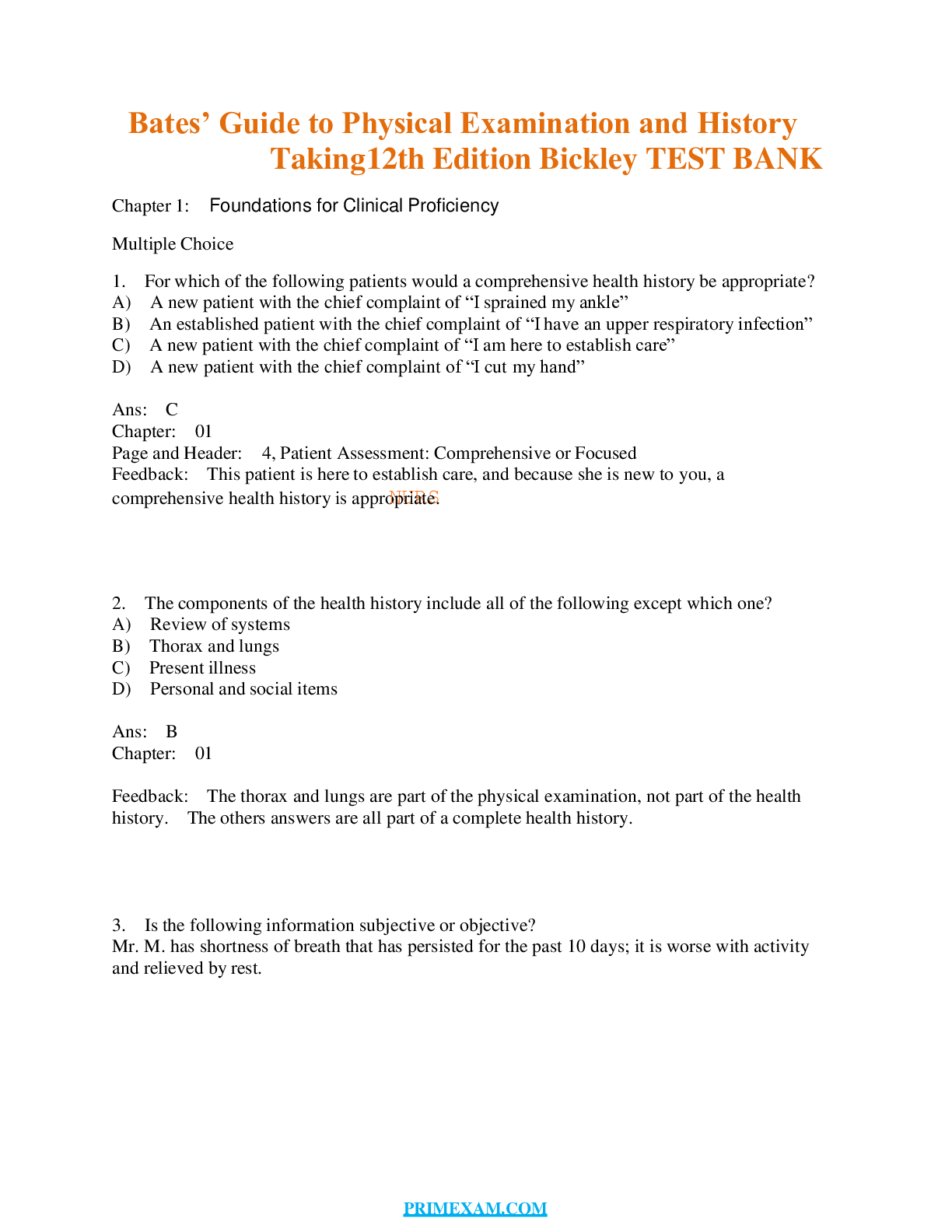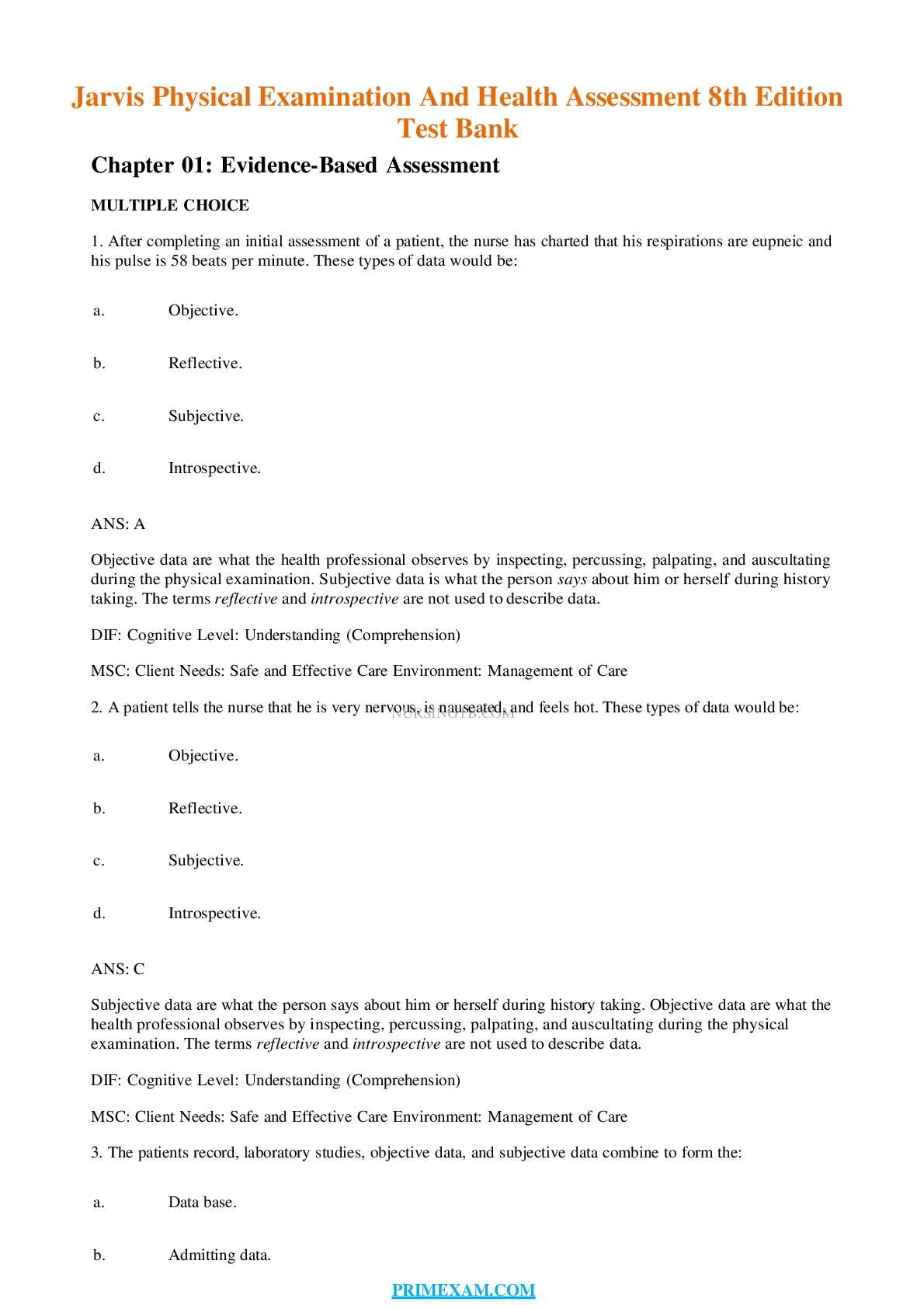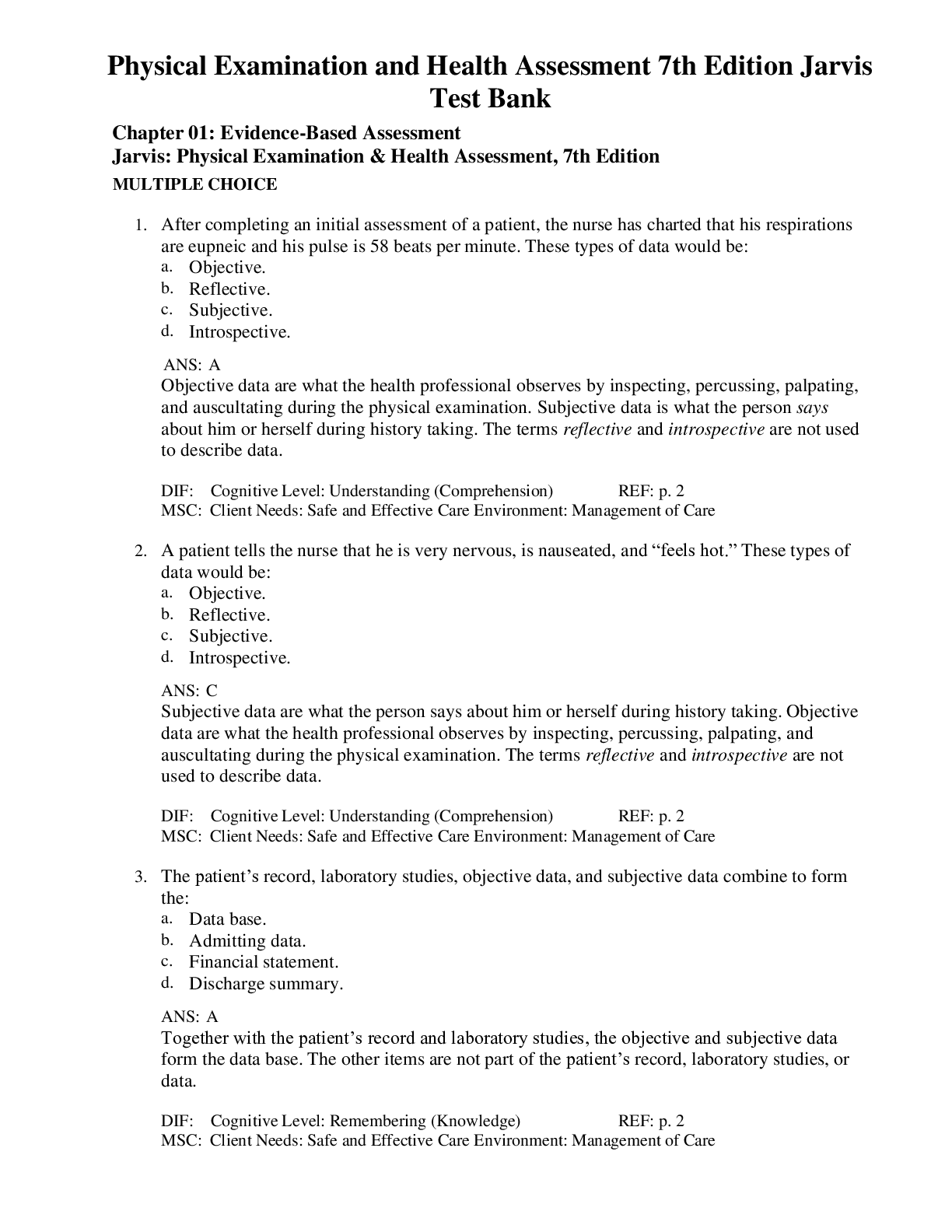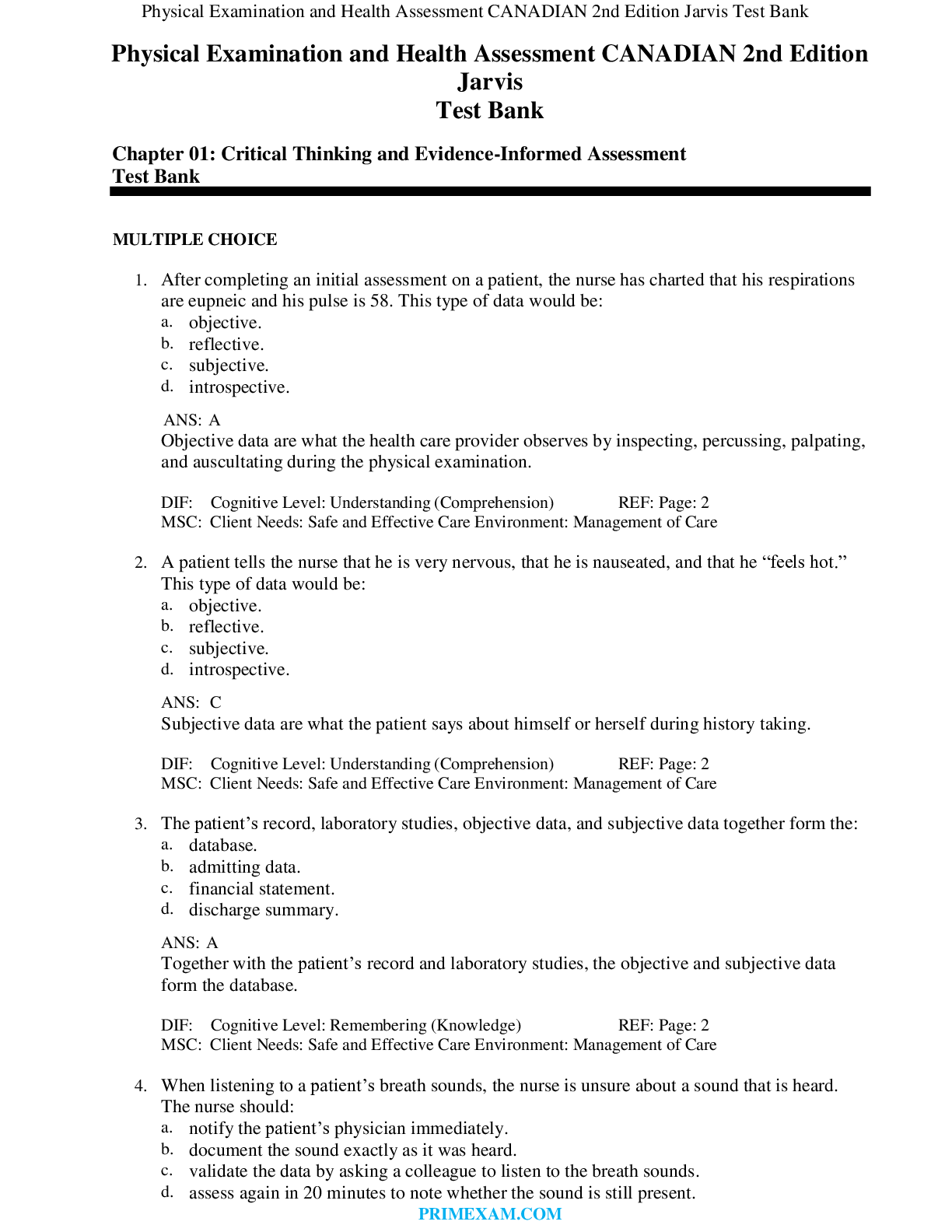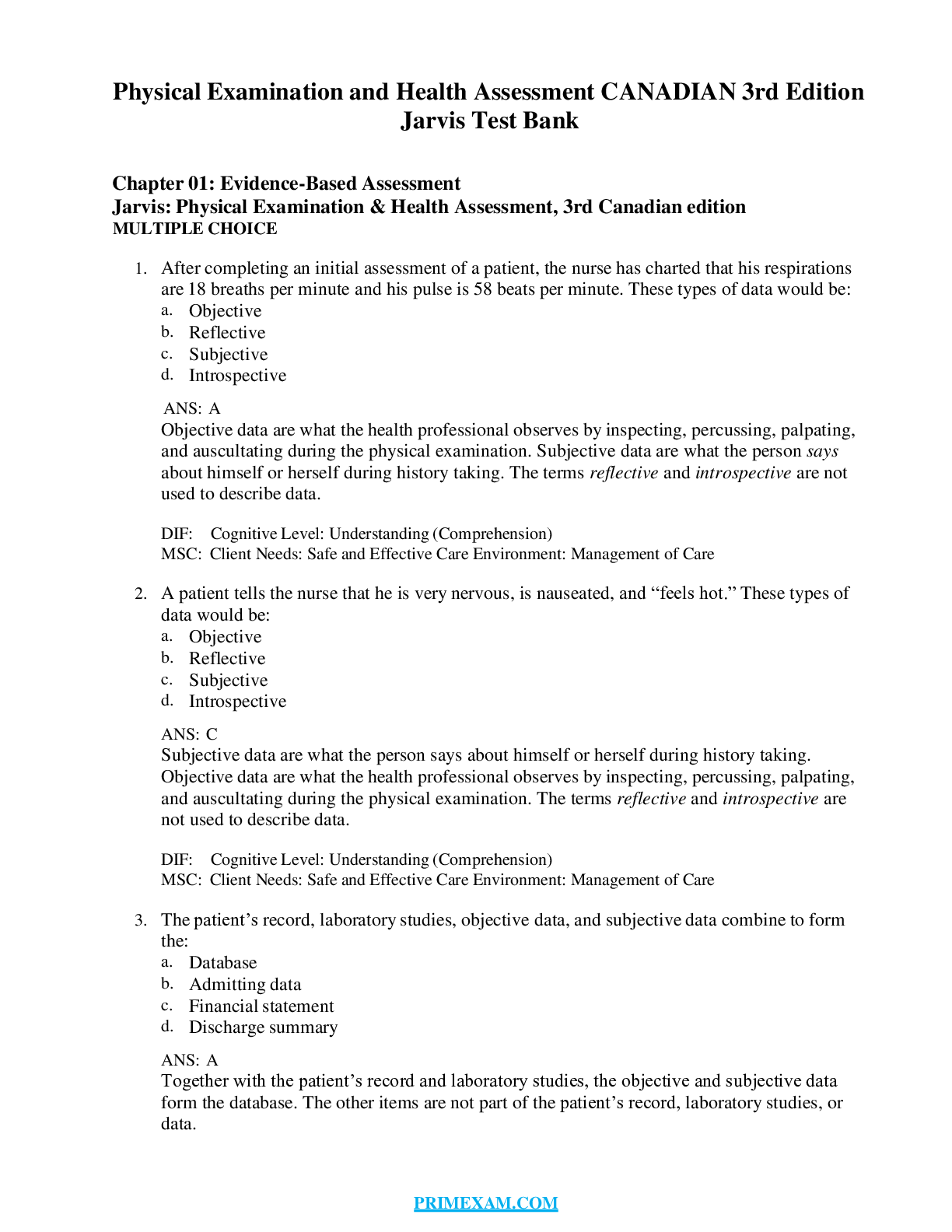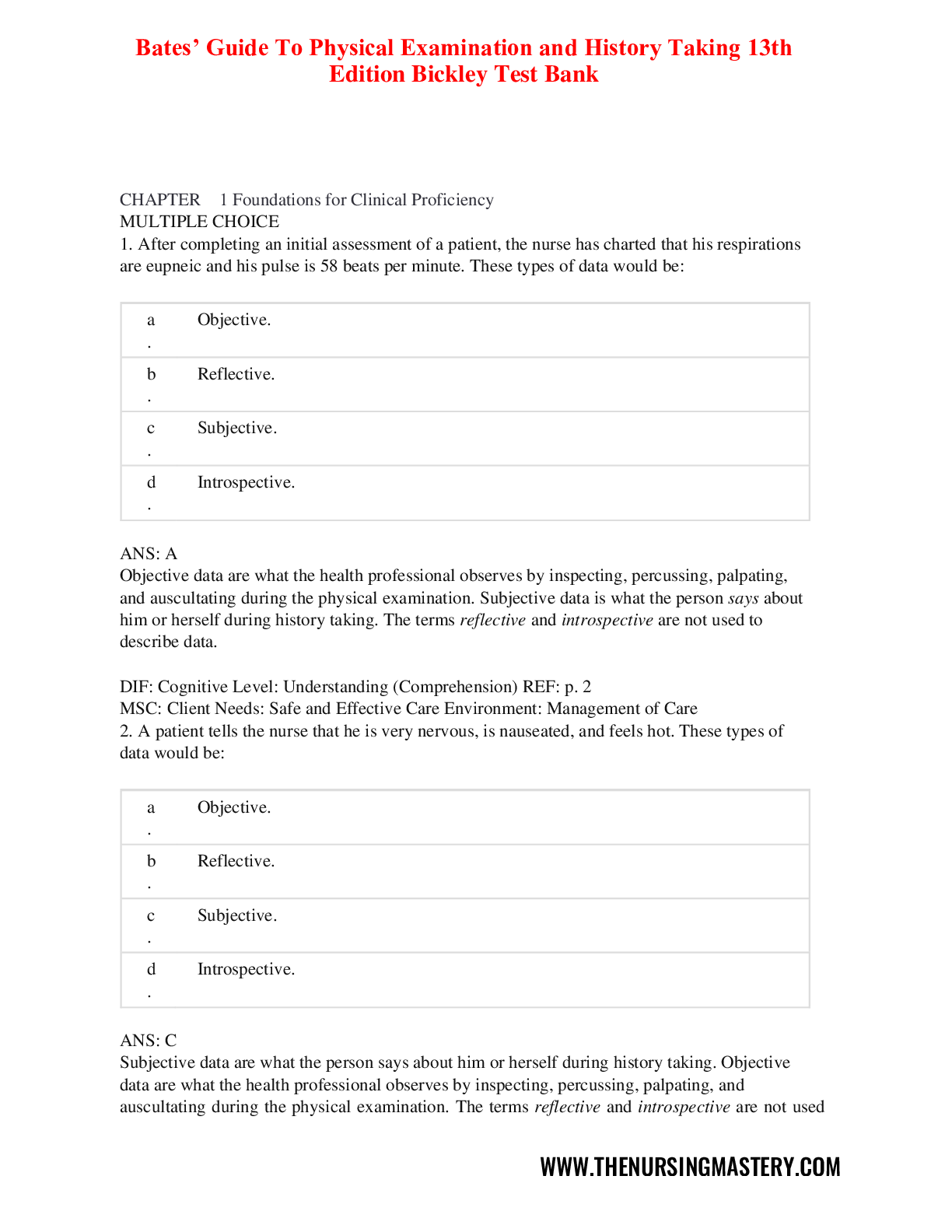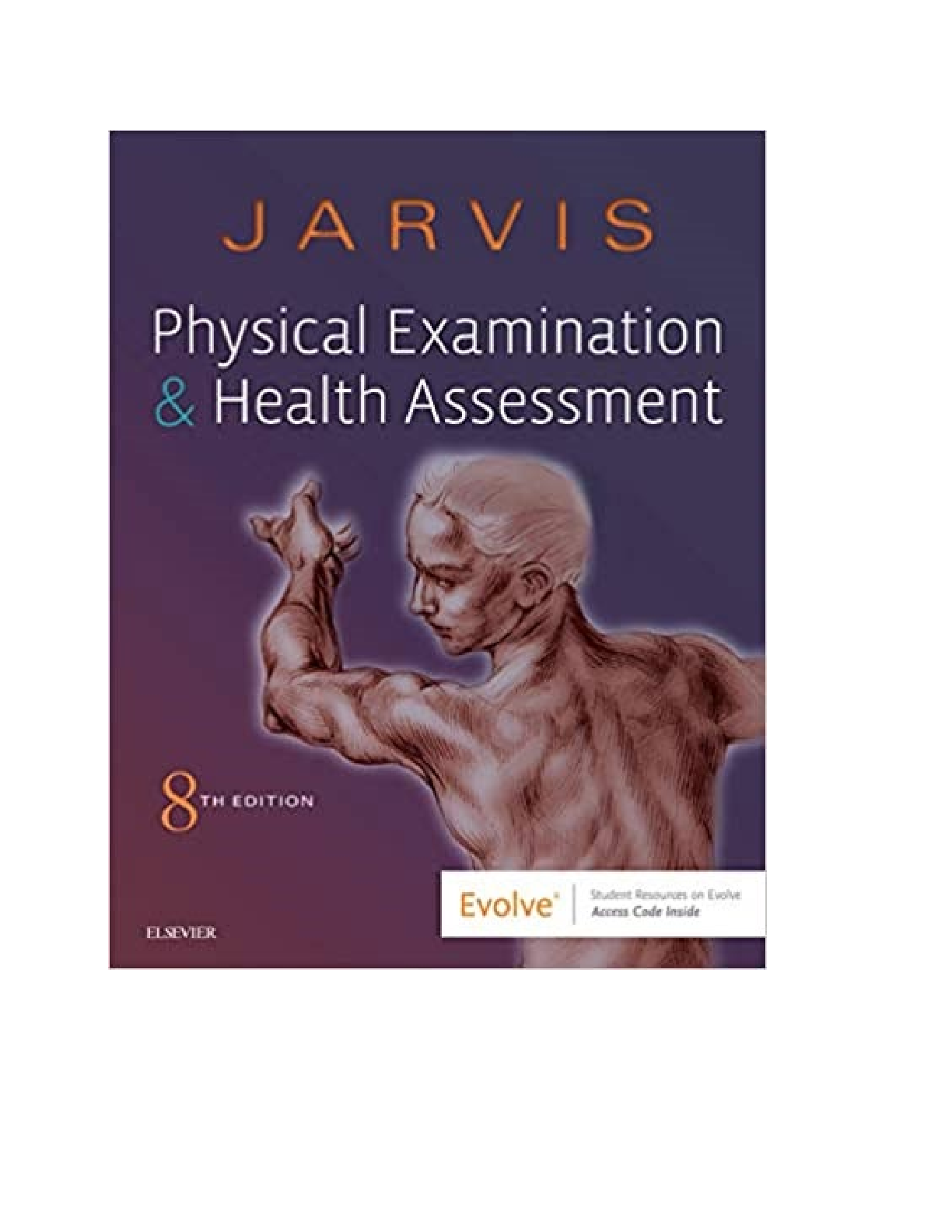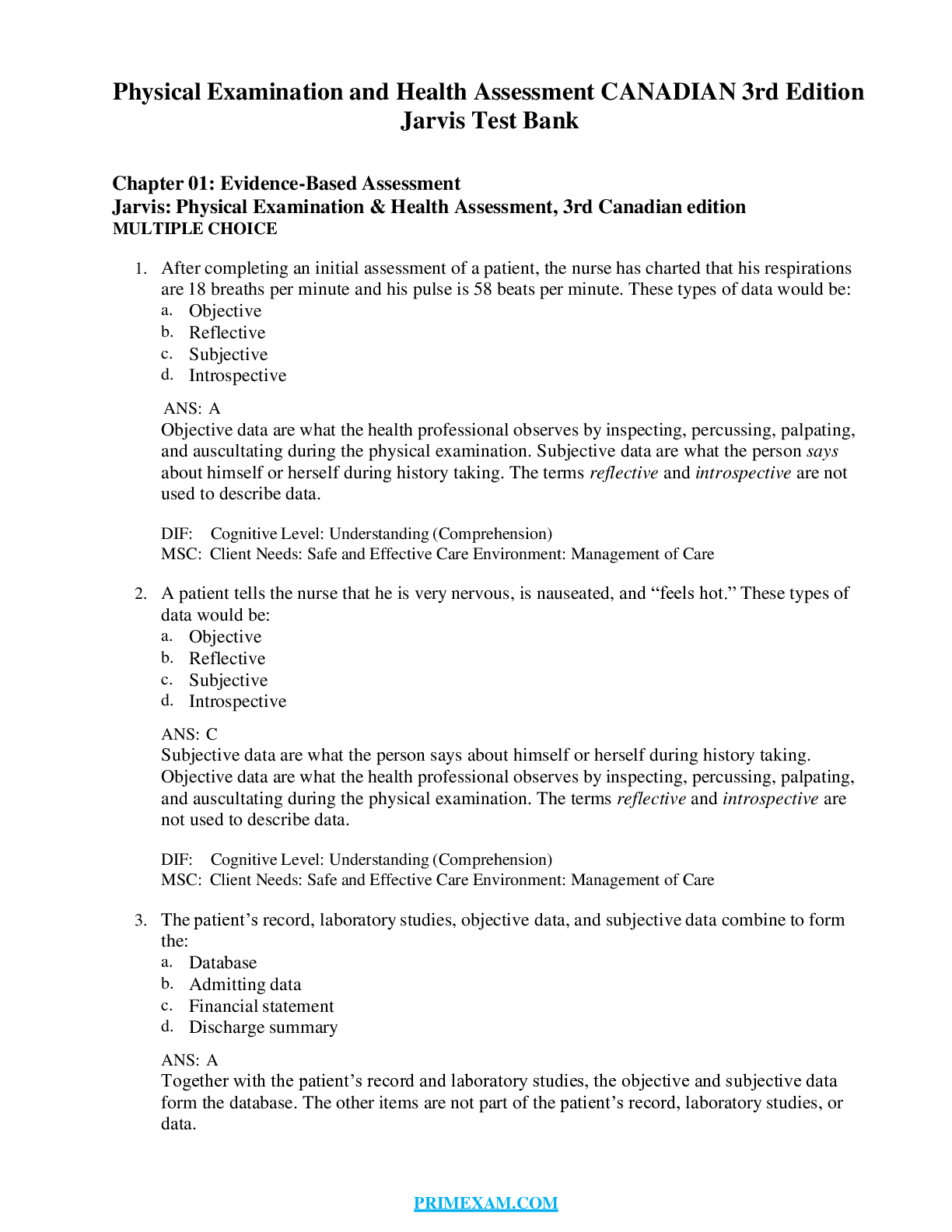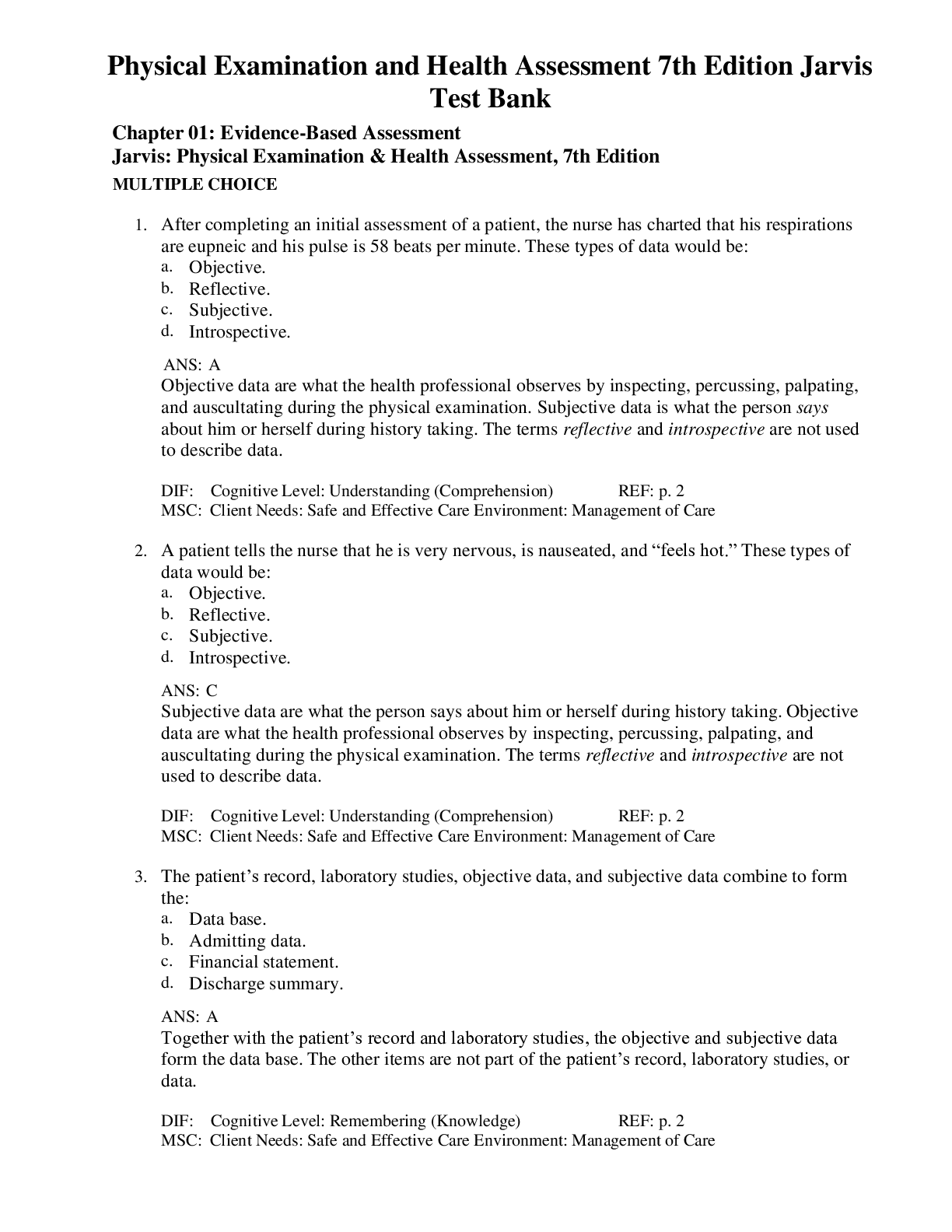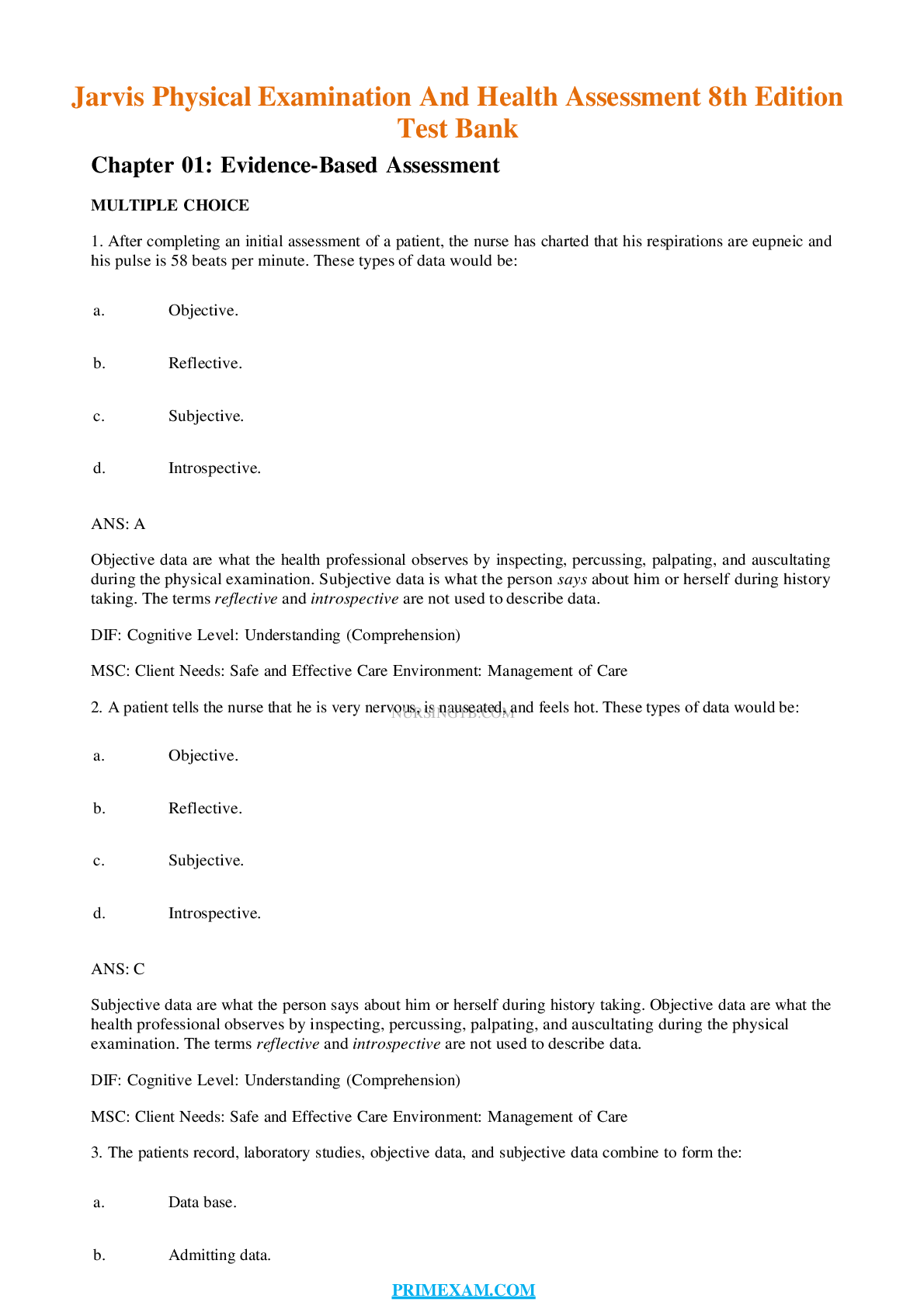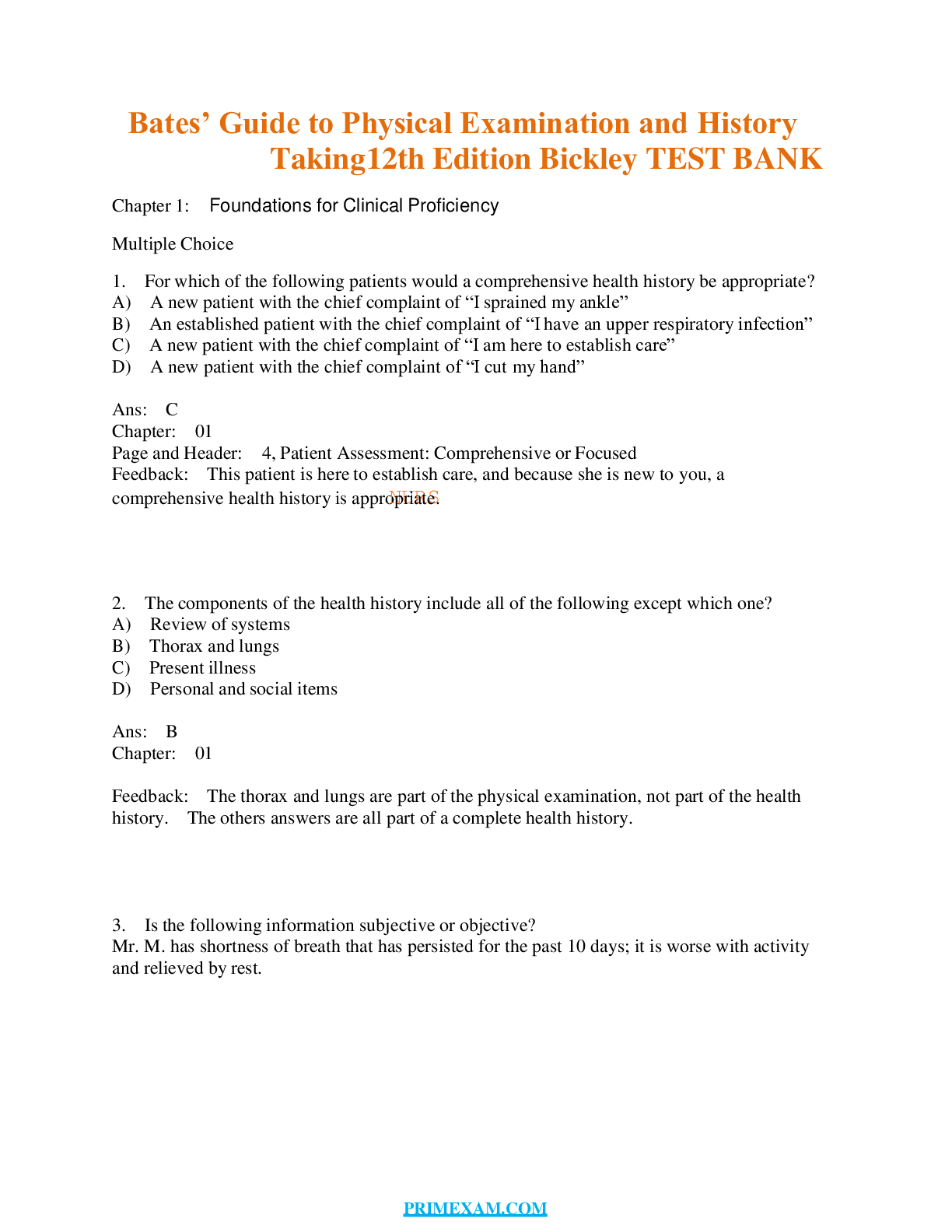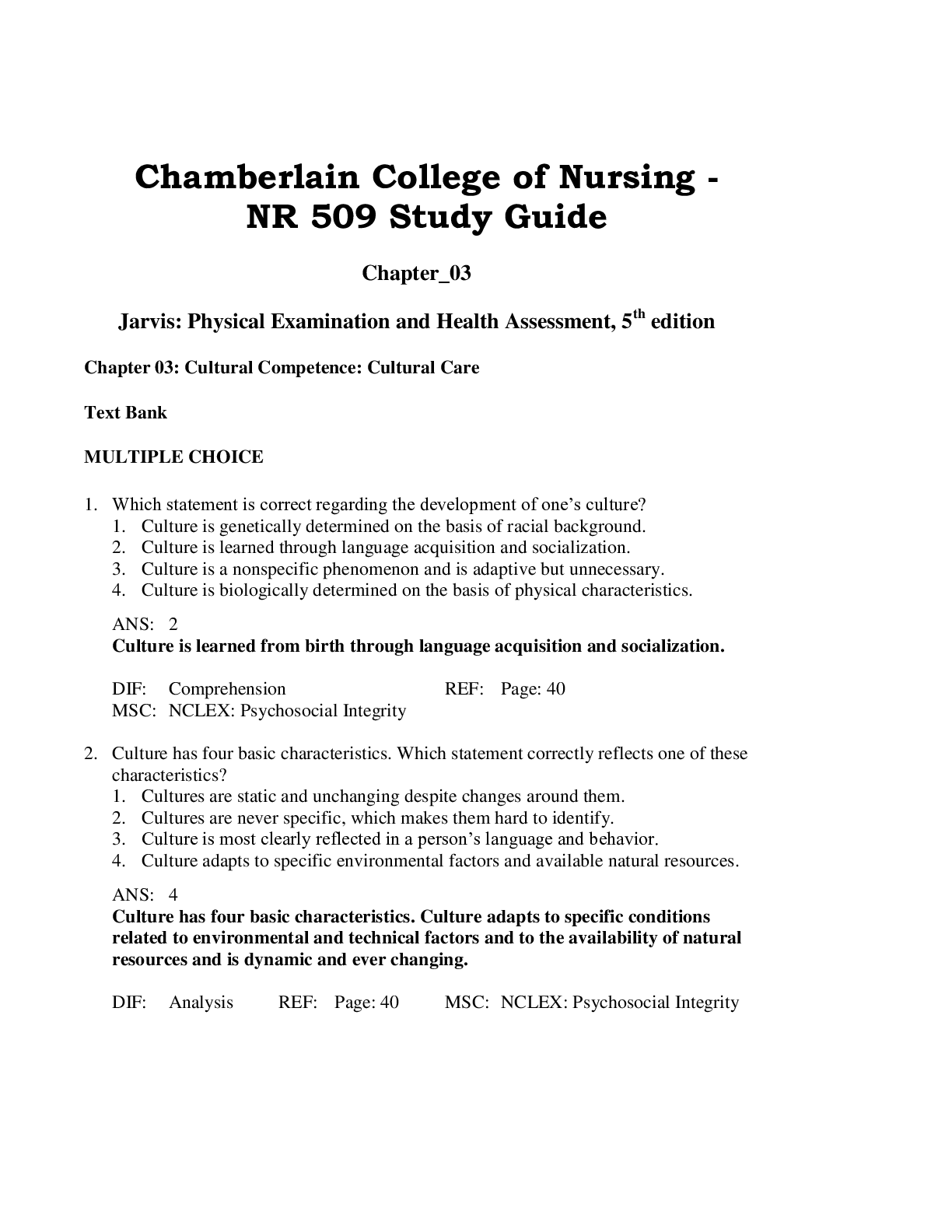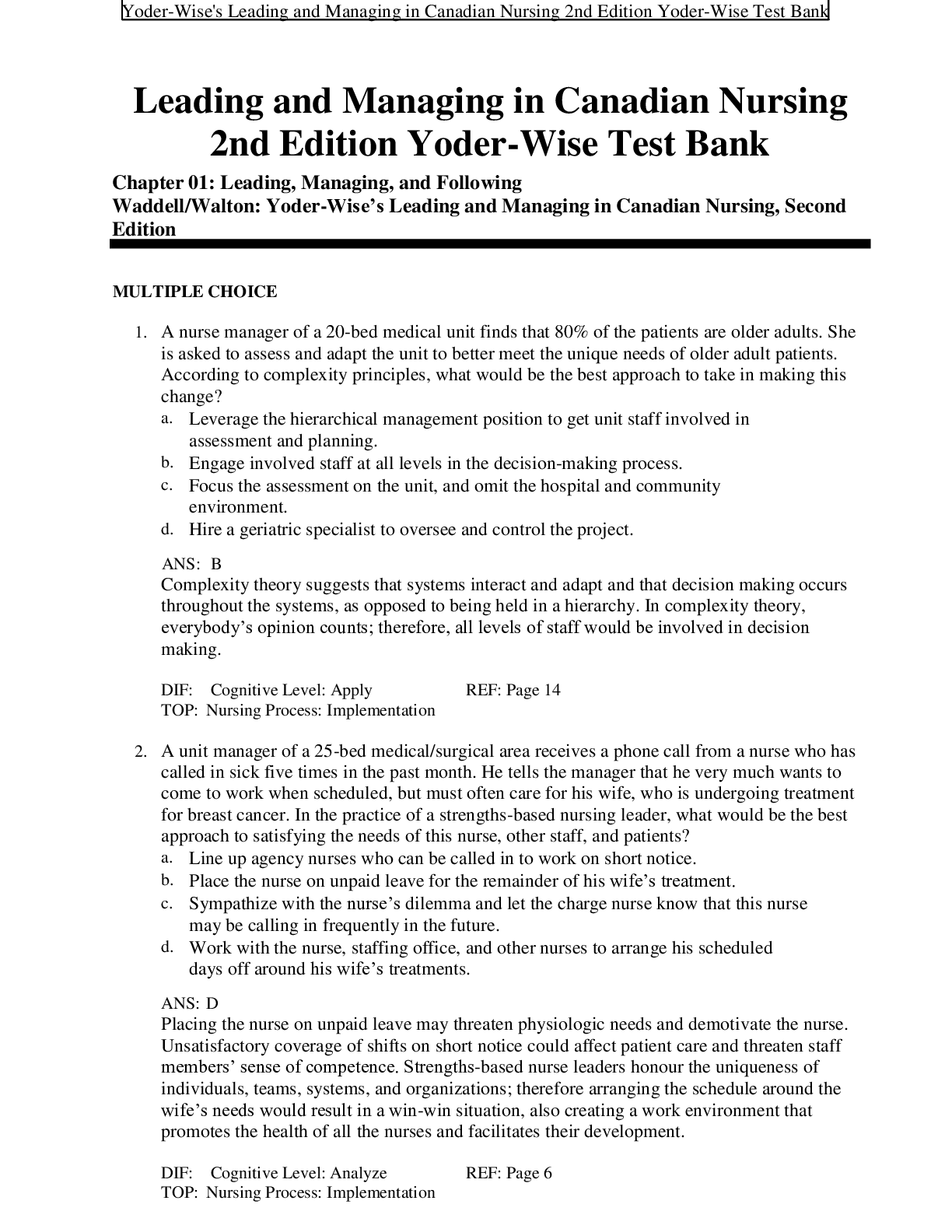*NURSING > TEST BANK > SOLVED TEST BANK!!! NR 509 PHYSICAL EXAMINATION AND HEALTH ASSESSMENT 8TH EDITION JARVIS TEST BANK ( (All)
SOLVED TEST BANK!!! NR 509 PHYSICAL EXAMINATION AND HEALTH ASSESSMENT 8TH EDITION JARVIS TEST BANK (CHAPTERS 1 TO 31)
Document Content and Description Below
SOLVED TEST BANK!!! NR 509 PHYSICAL EXAMINATION AND HEALTH ASSESSMENT 8TH EDITION JARVIS TEST BANK (CHAPTERS 1 TO 31). This pack contains almost everything you need to pass this module and do your ass... ignments. Good luck and i hope this helps! ______ Chapter 01: Evidence-Based Assessment MULTIPLE CHOICE 1. After completing an initial assessment of a patient, the nurse has charted that his respirations are eupneic and his pulse is 58 beats per minute. These types of data would be: a. Objective. b. c. d. ANS: A Objective data are what the health professional observes by inspecting, percussing, palpating, and auscultating during the physical examination. Subjective data is what the person says about him or herself during history taking. The terms reflective and introspective are not used to describe data. DIF: Cognitive Level: Understanding (Comprehension) MSC: Client Needs: Safe and Effective Care Environment: Management of Care 2. A patient tells the nurse that he is very nervous, is nauseated, and feels hot. These types of data would be: a. NURSINGTB.COM Objective. b. c. d. ANS: C Subjective data are what the person says about him or herself during history taking. Objective data are what the health professional observes by inspecting, percussing, palpating, and auscultating during the physical examination. The terms reflective and introspective are not used to describe data. DIF: Cognitive Level: Understanding (Comprehension) MSC: Client Needs: Safe and Effective Care Environment: Management of Care 3. The patients record, laboratory studies, objective data, and subjective data combine to form the: a. Data base. b. Admitting data. Reflective. Subjective. Introspective. Reflective. Subjective. Introspective. 2 NURSINGTB.COM TestsBanknursing.comPHYSICAL EXAMINATION AND HEALTH ASSESSMENT 8TH EDITION JARVIS TEST BANK Test Bank - Physical Examination and Health Assessment 8e (by Jarvis) 3 c. d. ANS: A Together with the patients record and laboratory studies, the objective and subjective data form the data base. The other items are not part of the patients record, laboratory studies, or data. DIF: Cognitive Level: Remembering (Knowledge) MSC: Client Needs: Safe and Effective Care Environment: Management of Care 4. When listening to a patients breath sounds, the nurse is unsure of a sound that is heard. The nurses next action should be to: a. Immediately notify the patients physician. b. c. d. ANS: C When unsure of a sound heard while listening to a patients breath sounds, the nurse validates the data to ensure accuracy. If the nurse has less experience in an area, then he or she asks an expert to listen. DIF: Cognitive Level: Analyzing (Analysis) MSC: Client Needs: Safe and Effective Care Environment: Management of Care 5. The nurse is conducting a class for new graduate nurses. During the teaching session, the nurse should keep in mind that novice nurses, without a background of skills and experience from which to draw, are more likely to make their decisions using: a. b. c. d. Intuition. A set of rules. Articles in journals. Advice from supervisors. ANS: B Novice nurses operate from a set of defined, structured rules. The expert practitioner uses intuitive links. DIF: Cognitive Level: Understanding (Comprehension) Document the sound exactly as it was heard. Validate the data by asking a coworker to listen to the breath sounds. Assess again in 20 minutes to note whether the sound is still present. NURSINGTB.COM Financial statement. Discharge summary. NURSINGTB.COM TestsBanknursing.comPHYSICAL EXAMINATION AND HEALTH ASSESSMENT 8TH EDITION JARVIS TEST BANK Test Bank - Physical Examination and Health Assessment 8e (by Jarvis) MSC: Client Needs: General 6. Expert nurses learn to attend to a pattern of assessment data and act without consciously labeling it. These responses are referred to as: a. Intuition. b. c. d. ANS: A Intuition is characterized by pattern recognitionexpert nurses learn to attend to a pattern of assessment data and act without consciously labeling it. The other options are not correct. DIF: Cognitive Level: Understanding (Comprehension) MSC: Client Needs: General 7. The nurse is reviewing information about evidence-based practice (EBP). Which statement best reflects EBP? a. EBP relies on tradition for support of best practices.NURSINGTB.COM b. c. d. ANS: C EBP is a systematic approach to practice that emphasizes the use of best evidence in combination with the clinicians experience, as well as patient preferences and values, when making decisions about care and treatment. EBP is more than simply using the best practice techniques to treat patients, and questioning tradition is important when no compelling and supportive research evidence exists. DIF: Cognitive Level: Applying (Application) MSC: Client Needs: Safe and Effective Care Environment: Management of Care 8. The nurse is conducting a class on priority setting for a group of new graduate nurses. Which is an example of a first-level priority problem? a. Patient with postoperative pain b. Newly diagnosed patient with diabetes who needs diabetic teaching EBP is simply the use of best practice techniques for the treatment of patients. EBP emphasizes the use of best evidence with the clinicians experience. The patients own preferences are not important with EBP. The nursing process. Clinical knowledge. Diagnostic reasoning. 4 NURSINGTB.COM TestsBanknursing.comPHYSICAL EXAMINATION AND HEALTH ASSESSMENT 8TH EDITION JARVIS TEST BANK Test Bank - Physical Examination and Health Assessment 8e (by Jarvis) c. d. ANS: D First-level priority problems are those that are emergent, life threatening, and immediate (e.g., establishing an airway, supporting breathing, maintaining circulation, monitoring abnormal vital signs). DIF: Cognitive Level: Understanding (Comprehension) MSC: Client Needs: Safe and Effective Care Environment: Management of Care 9. When considering priority setting of problems, the nurse keeps in mind that second-level priority problems include which of these aspects? a. Low self-esteem b. c. d. ANS: C Lack of knowledge Abnormal laboratory values Severely abnormal vital signs NURSINGTB.COM Second-level priority problems are those that require prompt intervention to forestall further deterioration (e.g., mental status change, acute pain, abnormal laboratory values, risks to safety or security). DIF: Cognitive Level: Understanding (Comprehension) MSC: Client Needs: Safe and Effective Care Environment: Management of Care 10. Which critical thinking skill helps the nurse see relationships among the data? a. Validation b. c. d. Clustering related cues Identifying gaps in data Distinguishing relevant from irrelevant ANS: B Clustering related cues helps the nurse see relationships among the data. DIF: Cognitive Level: Understanding (Comprehension) MSC: Client Needs: Safe and Effective Care Environment: Management of Care Individual with a small laceration on the sole of the foot Individual with shortness of breath and respiratory distress 5 NURSINGTB.COM TestsBanknursing.comPHYSICAL EXAMINATION AND HEALTH ASSESSMENT 8TH EDITION JARVIS TEST BANK Test Bank - Physical Examination and Health Assessment 8e (by Jarvis) 11. The nurse knows that developing appropriate nursing interventions for a patient relies on the appropriateness of the __________ diagnosis. a. b. c. d. ANS: A An accurate nursing diagnosis provides the basis for the selection of nursing interventions to achieve outcomes for which the nurse is accountable. The other items do not contribute to the development of appropriate nursing interventions. DIF: Cognitive Level: Understanding (Comprehension) MSC: Client Needs: Safe and Effective Care Environment: Management of Care 12. The nursing process is a sequential method of problem solving that nurses use and includes which steps? a. Assessment, treatment, planning, evaluation, discharge, and follow-up NURSINGTB.COM b. c. d. ANS: D The nursing process is a method of problem solving that includes assessment, diagnosis, outcome identification, planning, implementation, and evaluation. DIF: Cognitive Level: Understanding (Comprehension) MSC: Client Needs: Safe and Effective Care Environment: Management of Care 13. A newly admitted patient is in acute pain, has not been sleeping well lately, and is having difficulty breathing. How should the nurse prioritize these problems? a. Breathing, pain, and sleep b. c. Breathing, sleep, and pain Sleep, breathing, and pain Admission, assessment, diagnosis, treatment, and discharge planning Admission, diagnosis, treatment, evaluation, and discharge planning Assessment, diagnosis, outcome identification, planning, implementation, and evaluation Nursing Medical Admission Collaborative 6 NURSINGTB.COM TestsBanknursing.comPHYSICAL EXAMINATION AND HEALTH ASSESSMENT 8TH EDITION JARVIS TEST BANK Test Bank - Physical Examination and Health Assessment 8e (by Jarvis) d. ANS: A First-level priority problems are immediate priorities, remembering the ABCs (airway, breathing, and circulation), followed by second-level problems, and then third-level problems. DIF: Cognitive Level: Analyzing (Analysis) MSC: Client Needs: Safe and Effective Care Environment: Management of Care 14. Which of these would be formulated by a nurse using diagnostic reasoning? a. Nursing diagnosis b. c. d. ANS: C Diagnostic reasoning calls for the nurse to formulate a diagnostic hypothesis; the nursing process calls for a nursing diagnosis. DIF: Cognitive Level: Understanding (Comprehension) MSC: Client Needs: General 15. Barriers to incorporating EBP include: a. NURSINGTB.COM Nurses lack of research skills in evaluating the quality of research studies. b. c. d. ANS: A As individuals, nurses lack research skills in evaluating the quality of research studies, are isolated from other colleagues who are knowledgeable in research, and often lack the time to visit the library to read research. The other responses are not considered barriers. DIF: Cognitive Level: Understanding (Comprehension) MSC: Client Needs: General 16. What step of the nursing process includes data collection by health history, physical examination, and interview? Lack of significant research studies. Insufficient clinical skills of nurses. Inadequate physical assessment skills. Medical diagnosis Diagnostic hypothesis Diagnostic assessment Sleep, pain, and breathing 7 NURSINGTB.COM TestsBanknursing.comPHYSICAL EXAMINATION AND HEALTH ASSESSMENT 8TH EDITION JARVIS TEST BANK Test Bank - Physical Examination and Health Assessment 8e (by Jarvis) 8 a. b. c. d. ANS: D Data collection, including performing the health history, physical examination, and interview, is the assessment step of the nursing process. DIF: Cognitive Level: Remembering (Knowledge) MSC: Client Needs: General 17. During a staff meeting, nurses discuss the problems with accessing research studies to incorporate evidence-based clinical decision making into their practice. Which suggestion by the nurse manager would best help these problems? a. b. c. d. ANS: D Facilitating support for EBP would include teaching the nurses how to conduct electronic searches; time to visit the library may not be available for many nurses. Actually conducting research studies may be helpful in the long-run but not an immediate solution to reviewing existing research. DIF: Cognitive Level: Applying (Application) MSC: Client Needs: Safe and Effective Care Environment: Management of Care 18. When reviewing the concepts of health, the nurse recalls that the components of holistic health include which of these? a. Disease originates from the external environment. b. c. The individual human is a closed system. Nurses are responsible for a patients health state. Form a committee to conduct research studies. Post published research studies on the uniNURSINGTB.COMts bulletin boards. Encourage the nurses to visit the library to review studies. Teach the nurses how to conduct electronic searches for research studies. Planning Diagnosis Evaluation Assessment NURSINGTB.COM TestsBanknursing.comPHYSICAL EXAMINATION AND HEALTH ASSESSMENT 8TH EDITION JARVIS TEST BANK Test Bank - Physical Examination and Health Assessment 8e (by Jarvis) d. ANS: D Consideration of the whole person is the essence of holistic health, which views the mind, body, and spirit as interdependent. The basis of disease originates from both the external environment and from within the person. Both the individual human and the external environment are open systems, continually changing and adapting, and each person is responsible for his or her own personal health state. DIF: Cognitive Level: Understanding (Comprehension) MSC: Client Needs: Safe and Effective Care Environment: Management of Care 19. The nurse recognizes that the concept of prevention in describing health is essential because: a. Disease can be prevented by treating the external environment. b. c. d. ANS: C A natural progression to prevention rounds out the present concept of health. Guidelines to prevention place the emphasis on the link between health and personal behavior. DIF: Cognitive Level: Understanding (Comprehension) MSC: Client Needs: General NURSINGTB.COM 20. The nurse is performing a physical assessment on a newly admitted patient. An example of objective information obtained during the physical assessment includes the: a. Patients history of allergies. b. c. d. ANS: D Objective data are the patients record, laboratory studies, and condition that the health professional observes by inspecting, percussing, palpating, and auscultating during the physical examination. The other responses reflect subjective data. DIF: Cognitive Level: Applying (Application) Patients use of medications at home. Last menstrual period 1 month ago. 2 5 cm scar on the right lower forearm. The majority of deaths among Americans under age 65 years are not preventable. Prevention places the emphasis on the link between health and personal behavior. The means to prevention is through treatment provided by primary health care practitioners. Holistic health views the mind, body, and spirit as interdependent. 9 NURSINGTB.COM TestsBanknursing.comPHYSICAL EXAMINATION AND HEALTH ASSESSMENT 8TH EDITION JARVIS TEST BANK Test Bank - Physical Examination and Health Assessment 8e (by Jarvis) MSC: Client Needs: Safe and Effective Care Environment: Management of Care 21. A visiting nurse is making an initial home visit for a patient who has many chronic medical problems. Which type of data base is most appropriate to collect in this setting? a. A follow-up data base to evaluate changes at appropriate intervals b. c. d. ANS: C The complete data base is collected in a primary care setting, such as a pediatric or family practice clinic, independent or group private practice, college health service, womens health care agency, visiting nurse agency, or community health agency. In these settings, the nurse is the first health professional to see the patient and has the primary responsibility for monitoring the persons health care. DIF: Cognitive Level: Applying (Application) MSC: Client Needs: Safe and Effective Care Environment: Management of Care 22. Which situation is most appropriate during which the nurse performs a focused or problem-centered history? a. NURSINGTB.COM Patient is admitted to a long-term care facility. b. c. d. ANS: D In a focused or problem-centered data base, the nurse collects a mini data base, which is smaller in scope than the completed data base. This mini data base primarily concerns one problem, one cue complex, or one body system. DIF: Cognitive Level: Applying (Application) MSC: Client Needs: Safe and Effective Care Environment: Management of Care 23. A patient is at the clinic to have her blood pressure checked. She has been coming to the clinic weekly since she changed medications 2 months ago. The nurse should: a. Collect a follow-up data base and then check her blood pressure. Patient has a sudden and severe shortness of breath. Patient is admitted to the hospital for surgery the following day. Patient in an outpatient clinic has cold and influenza-like symptoms. An episodic data base because of the continuing, complex medical problems of this patient A complete health data base because of the nurses primary responsibility for monitoring the patients health An emergency data base because of the need to collect information and make accurate diagnoses rapidly 10 NURSINGTB.COM TestsBanknursing.comPHYSICAL EXAMINATION AND HEALTH ASSESSMENT 8TH EDITION JARVIS TEST BANK Test Bank - Physical Examination and Health Assessment 8e (by Jarvis) 11 b. c. d. ANS: A A follow-up data base is used in all settings to follow up short-term or chronic health problems. The other responses are not appropriate for the situation. DIF: Cognitive Level: Applying (Application) MSC: Client Needs: Safe and Effective Care Environment: Management of Care 24. A patient is brought by ambulance to the emergency department with multiple traumas received in an automobile accident. He is alert and cooperative, but his injuries are quite severe. How would the nurse proceed with data collection? a. b. c. d. ANS: B The emergency data base calls for a rapid collection of the data base, often concurrently compiled with life- saving measures. The other responses are not appropriate for the situation. DIF: Cognitive Level: Analyzing (Analysis) MSC: Client Needs: Safe and Effective Care Environment: Management of Care 25. A 42-year-old patient of Asian descent is being seen at the clinic for an initial examination. The nurse knows that including cultural information in his health assessment is important to: a. Identify the cause of his illness. b. c. Make accurate disease diagnoses. Provide cultural health rights for the individual. Collect history information first, then perform the physical examination and institute life-saving measures. Simultaneously ask history questions while performing the examination and initiating life-saving measures. NURSINGTB.COM Collect all information on the history form, including social support patterns, strengths, and coping patterns. Perform life-saving measures and delay asking any history questions until the patient is transferred to the intensive care unit. Ask her to read her health record and indicate any changes since her last visit. Check only her blood pressure because her complete health history was documented 2 months ago. Obtain a complete health history before checking her blood pressure because much of her history information may have changed. NURSINGTB.COM TestsBanknursing.comPHYSICAL EXAMINATION AND HEALTH ASSESSMENT 8TH EDITION JARVIS TEST BANK Test Bank - Physical Examination and Health Assessment 8e (by Jarvis) d. ANS: D The inclusion of cultural considerations in the health assessment is of paramount importance to gathering data that are accurate and meaningful and to intervening with culturally sensitive and appropriate care. DIF: Cognitive Level: Understanding (Comprehension) MSC: Client Needs: Psychosocial Integrity 26. In the health promotion model, the focus of the health professional includes: a. Changing the patients perceptions of disease. b. c. d. ANS: D In the health promotion model, the focus of the health professional is on helping the consumer choose a healthier lifestyle. DIF: Cognitive Level: Remembering (Knowledge) MSC: Client Needs: Health Promotion and Maintenance NURSINGTB.COM 27. The nurse has implemented several planned interventions to address the nursing diagnosis of acute pain. Which would be the next appropriate action? a. Establish priorities. b. c. d. ANS: C Evaluation is the next step after the implementation phase of the nursing process. During this step, the nurse evaluates the individuals condition and compares the actual outcomes with expected outcomes. DIF: Cognitive Level: Applying (Application) MSC: Client Needs: Safe and Effective Care Environment: Management of Care 28. Which statement best describes a proficient nurse? A proficient nurse is one who: Identify expected outcomes. Evaluate the individuals condition, and compare actual outcomes with expected outcomes. Interpret data, and then identify clusters of cues and make inferences. Identifying biomedical model interventions. Identifying negative health acts of the consumer. Helping the consumer choose a healthier lifestyle. Provide culturally sensitive and appropriate care. 12 NURSINGTB.COM TestsBanknursing.comPHYSICAL EXAMINATION AND HEALTH ASSESSMENT 8TH EDITION JARVIS TEST BANK Test Bank - Physical Examination and Health Assessment 8e (by Jarvis) a. b. c. d. ANS: D The proficient nurse, with more time and experience than the novice nurse, is able to understand a patient situation as a whole rather than as a list of tasks. The proficient nurse is able to see how todays nursing actions can apply to the point the nurse wants the patient to reach at a future time. DIF: Cognitive Level: Applying (Application) MSC: Client Needs: General MULTIPLE RESPONSE 1. The nurse is reviewing data collected after an assessment. Of the data listed below, which would be considered related cues that would be clustered together during data analysis? Select all that apply. a. Inspiratory wheezes noted in left lower lobes NURSINGTB.COM b. c. d. e. f. Hypoactive bowel sounds Nonproductive cough Edema, +2, noted on left hand Patient reports dyspnea upon exertion Rate of respirations 16 breaths per minute ANS: A, C, E, F Clustering related cues help the nurse recognize relationships among the data. The cues related to the patients respiratory status (e.g., wheezes, cough, report of dyspnea, respiration rate and rhythm) are all related. Cues related to bowels and peripheral edema are not related to the respiratory cues. DIF: Cognitive Level: Analyzing (Analysis) MSC: Client Needs: Safe and Effective Care Environment: Management of Care MATCHING Put the following patient situations in order according to the level of priority. Has little experience with a specified population and uses rules to guide performance. Has an intuitive grasp of a clinical situation and quickly identifies the accurate solution. Sees actions in the context of daily plans for patients. Understands a patient situation as a whole rather than a list of tasks and recognizes the long-term goals for the patient. 13 NURSINGTB.COM TestsBanknursing.comPHYSICAL EXAMINATION AND HEALTH ASSESSMENT 8TH EDITION JARVIS TEST BANK Test Bank - Physical Examination and Health Assessment 8e (by Jarvis) a. b. c. A patient newly diagnosed with type 2 diabetes mellitus does not know how to check his own blood glucose levels with a glucometer. A teenager who was stung by a bee during a soccer match is having trouble breathing. An older adult with a urinary tract infection is also showing signs of confusion and agitation. 1. a = First-level priority problem 2. b = Second-level priority problem 3. c = Third-level priority problem 1. ANS: B DIF: Cognitive Level: Analyzing (Analysis) MSC: Client Needs: Safe and Effective Care Environment: Management of Care NOT: First-level priority problems are immediate priorities, such as trouble breathing (remember the airway, breathing, circulation priorities). Second-level priority problems are next in urgency, but not life-threatening. Third-level priorities (e.g., patient education) are important to a patients health but can be addressed after more urgent health problems are addressed. 2. ANS: C DIF: Cognitive Level: Analyzing (Analysis) MSC: Client Needs: Safe and Effective Care Environment: Management of Care NOT: First-level priority problems are immediate priorities, such as trouble breathing (remember the airway, breathing, circulation priorities). Second-level priority problems are next in urgency, but not life-threatening. Third-level priorities (e.g., patient education) are important to a patients health but can be addressed after more urgent health problems are addressed. NURSINGTB.COM 3. ANS: A DIF: Cognitive Level: Analyzing (Analysis) MSC: Client Needs: Safe and Effective Care Environment: Management of Care NOT: First-level priority problems are immediate priorities, such as trouble breathing (remember the airway, breathing, circulation priorities). Second-level priority problems are next in urgency, but not life-threatening. Third-level priorities (e.g., patient education) are important to a patients health but can be addressed after more urgent health problems are addressed. 14 NURSINGTB.COM TestsBanknursing.comPHYSICAL EXAMINATION AND HEALTH ASSESSMENT 8TH EDITION JARVIS TEST BANK Test Bank - Physical Examination and Health Assessment 8e (by Jarvis) Chapter 02: Cultural Assessment MULTIPLE CHOICE 1. The nurse is reviewing the development of culture. Which statement is correct regarding the development of ones culture? Culture is: a. Genetically determined on the basis of racial background. b. c. d. ANS: B Culture is learned from birth through language acquisition and socialization. It is not biologically or genetically determined and is learned by the individual. DIF: Cognitive Level: Understanding (Comprehension) MSC: Client Needs: Psychosocial Integrity 2. During a class on the aspects of culture, the nurse shares that culture has four basic characteristics. Which statement correctly reflects one of these characteristics? a. NURSINGTB.COM Cultures are static and unchanging, despite changes around them. b. c. d. ANS: D Culture has four basic characteristics. Culture adapts to specific conditions related to environmental and technical factors and to the availability of natural resources, and it is dynamic and ever changing. Culture is learned from birth through the process of language acquisition and socialization, but it is not most clearly reflected in ones language and behavior. DIF: Cognitive Level: Analyzing (Analysis) MSC: Client Needs: Psychosocial Integrity 3. During a seminar on cultural aspects of nursing, the nurse recognizes that the definition stating the specific and distinct knowledge, beliefs, skills, and customs acquired by members of a society reflects which term? a. Mores Cultures are never specific, which makes them hard to identify. Culture is most clearly reflected in a persons language and behavior. Culture adapts to specific environmental factors and available natural resources. Learned through language acquisition and socialization. A nonspecific phenomenon and is adaptive but unnecessary. Biologically determined on the basis of physical characteristics. 15 NURSINGTB.COM TestsBanknursing.comPHYSICAL EXAMINATION AND HEALTH ASSESSMENT 8TH EDITION JARVIS TEST BANK Test Bank - Physical Examination and Health Assessment 8e (by Jarvis) b. c. d. ANS: C The culture that develops in any given society is always specific and distinctive, encompassing all of the knowledge, beliefs, customs, and skills acquired by members of the society. The other terms do not fit the given definition. DIF: Cognitive Level: Remembering (Knowledge) MSC: Client Needs: Psychosocial Integrity 4. When discussing the use of the term subculture, the nurse recognizes that it is best described as: a. Fitting as many people into the majority culture as possible. b. c. d. ANS: D Within cultures, groups of people share different beliefs, values, and attitudes. Differences occur because of ethnicity, religion, education, occupation, age, and gender. When such groups function within a large culture, they are referred to as subcultural groups. DIF: Cognitive Level: Understanding (Comprehension) MSC: Client Needs: Psychosocial Integrity 5. When reviewing the demographics of ethnic groups in the United States, the nurse recalls that the largest and fastest growing population is: a. Hispanic. b. c. d. ANS: A Black. Asian. American Indian. Defining small groups of people who do not want to be identified with the larger culture. Singling out groups of people who suffer differential and unequal treatment as a result of cultural variations. NURSINGTB.COM Identifying fairly large groups of people with shared characteristics that are not common to all members of a culture. Norms Culture Social learning 16 NURSINGTB.COM TestsBanknursing.comPHYSICAL EXAMINATION AND HEALTH ASSESSMENT 8TH EDITION JARVIS TEST BANK Test Bank - Physical Examination and Health Assessment 8e (by Jarvis) Hispanics are the largest and fastest growing population in the United States, followed by Asians, Blacks, American Indians and Alaska natives, and other groups. DIF: Cognitive Level: Remembering (Knowledge) MSC: Client Needs: General 6. During an assessment, the nurse notices that a patient is handling a small charm that is tied to a leather strip around his neck. Which action by the nurse is appropriate? a. Ask the patient about the item and its significance. b. c. d. ANS: A The nurse should inquire about the amulets meaning. Amulets, such as charms, are often considered an important means of protection from evil spirits by some cultures. DIF: Cognitive Level: Applying (Application) MSC: Client Needs: Psychosocial Integrity NURSINGTB.COM 7. The nurse manager is explaining culturally competent care during a staff meeting. Which statement accurately describes the concept of culturally competent care? The caregiver: a. Is able to speak the patients native language. b. c. d. ANS: D Culturally competent implies that the caregiver understands and attends to the total context of the individuals situation. This competency includes awareness of immigration status, stress factors, other social factors, and cultural similarities and differences. It does not require the caregiver to speak the patients native language. DIF: Cognitive Level: Analyzing (Analysis) MSC: Client Needs: Psychosocial Integrity 8. The nurse recognizes that an example of a person who is heritage consistent would be a: a. Woman who has adapted her clothing to the clothing style of her new country. Possesses some basic knowledge of the patients cultural background. Applies the proper background knowledge of a patients cultural background to provide the best possible health care. Understands and attends to the total context of the patients situation. Ask the patient to lock the item with other valuables in the hospitals safe. Tell the patient that a family member should take valuables home. No action is necessary. 17 NURSINGTB.COM TestsBanknursing.comPHYSICAL EXAMINATION AND HEALTH ASSESSMENT 8TH EDITION JARVIS TEST BANK Test Bank - Physical Examination and Health Assessment 8e (by Jarvis) 18 b. c. d. ANS: B Someone who is heritage consistent lives a lifestyle that reflects his or her traditional heritage, not the norms and customs of the new country. DIF: Cognitive Level: Understanding (Comprehension) MSC: Client Needs: Psychosocial Integrity 9. After a class on culture and ethnicity, the new graduate nurse reflects a correct understanding of the concept of ethnicity with which statement? a. Ethnicity is dynamic and ever changing. b. c. d. ANS: C Ethnicity pertains to a social group within the social system that claims to have variable traits, such as a common geographic origin, migratory status, religion, race, language, values, traditions, symbols, or food preferences.Culture is dynamic, ever changing, and learned from birth through the processes of language acquisition and socialization. Religion is the belief in a higher power. DIF: Cognitive Level: Applying (Application) MSC: Client Needs: Psychosocial Integrity 10. The nurse is comparing the concepts of religion and spirituality. Which of the following is an appropriate component of ones spirituality? a. Belief in and the worship of God or gods b. c. d. Attendance at a specific church or place of worship Personal effort made to find purpose and meaning in life Being closely tied to ones ethnic background Ethnicity is the belief in a higher power. Ethnicity pertains to a social group within the social system that claims shared values and traditions. NURSINGTB.COM Ethnicity is learned from birth through the processes of language acquisition and socialization. Woman who follows the traditions that her mother followed regarding meals. Man who is not sure of his ancestors country of origin. Child who is not able to speak his parents native language. NURSINGTB.COM TestsBanknursing.comPHYSICAL EXAMINATION AND HEALTH ASSESSMENT 8TH EDITION JARVIS TEST BANK Test Bank - Physical Examination and Health Assessment 8e (by Jarvis) ANS: C Spirituality refers to each persons unique life experiences and his or her personal effort to find purpose and meaning in life. The other responses apply to religion. DIF: Cognitive Level: Applying (Application) MSC: Client Needs: Psychosocial Integrity 11. A woman who has lived in the United States for a year after moving from Europe has learned to speak English and is almost finished with her college studies. She now dresses like her peers and says that her family in Europe would hardly recognize her. This nurse recognizes that this situation illustrates which concept? a. b. c. d. ANS: A Assimilation is the process by which a person develops a new cultural identity and becomes like members of the dominant culture. This concept does not reflect heritage consistency. Biculturalism is a dual pattern of identification; acculturation is the process of adapting to and acquiring another culture. NURSINGTB.COM DIF: Cognitive Level: Understanding (Comprehension) MSC: Client Needs: Psychosocial Integrity 12. The nurse is conducting a heritage assessment. Which question is most appropriate for this assessment? a. What is your religion? b. c. d. ANS: B Asking questions about participation in the religious traditions of family enables the nurse to assess a persons heritage. Simply asking about ones religion, smoking history, or health history does not reflect heritage. DIF: Cognitive Level: Applying (Application) MSC: Client Needs: Psychosocial Integrity 13. In the majority culture of America, coughing, sweating, and diarrhea are symptoms of an illness. For some individuals of Mexican-American origin, however, these symptoms are a normal part of living. The nurse recognizes that this difference is true, probably because Mexican-Americans: Do you mostly participate in the religious traditions of your family? Do you smoke? Do you have a history of heart disease? Assimilation Heritage consistency Biculturalism Acculturation 19 NURSINGTB.COM TestsBanknursing.comPHYSICAL EXAMINATION AND HEALTH ASSESSMENT 8TH EDITION JARVIS TEST BANK Test Bank - Physical Examination and Health Assessment 8e (by Jarvis) a. b. c. d. ANS: B The nurse needs to identify the meaning of health to the patient, remembering that concepts are derived, in part, from the way in which members of the cultural group define health. DIF: Cognitive Level: Understanding (Comprehension) MSC: Client Needs: Psychosocial Integrity 14. The nurse is reviewing theories of illness. The germ theory, which states that microscopic organisms such as bacteria and viruses are responsible for specific disease conditions, is a basic belief of which theory of illness? a. b. c. d. ANS: B Among the biomedical explanations for disease is the germ theory, which states that microscopic organisms such as bacteria and viruses are responsible for specific disease conditions. The naturalistic, or holistic, perspective holds that the forces of nature must be kept in natural balance. The magicoreligious perspective holds that supernatural forces dominate and cause illness or health. DIF: Cognitive Level: Understanding (Comprehension) MSC: Client Needs: Psychosocial Integrity 15. An Asian-American woman is experiencing diarrhea, which is believed to be cold or yin. The nurse expects that the woman is likely to try to treat it with: a. Foods that are hot or yang. b. c. d. Readings and Eastern medicine meditations. High doses of medicines believed to be cold. No treatment is tried because diarrhea is an expected part of life. Holistic Biomedical NURSINGTB.COM Naturalistic Magicoreligious Have less efficient immune systems and are often ill. Consider these symptoms part of normal living, not symptoms of ill health. Come from Mexico, and coughing is normal and healthy there. Are usually in a lower socioeconomic group and are more likely to be sick. 20 NURSINGTB.COM TestsBanknursing.comPHYSICAL EXAMINATION AND HEALTH ASSESSMENT 8TH EDITION JARVIS TEST BANK Test Bank - Physical Examination and Health Assessment 8e (by Jarvis) 21 ANS: A Yin foods are cold and yang foods are hot. Cold foods are eaten with a hot illness, and hot foods are eaten with a cold illness. The other explanations do not reflect the yin/yang theory. DIF: Cognitive Level: Applying (Application) MSC: Client Needs: Psychosocial Integrity 16. Many Asians believe in the yin/yang theory, which is rooted in the ancient Chinese philosophy of Tao. Which statement most accurately reflects health in an Asian with this belief? a. A person is able to work and produce. b. c. d. ANS: C Many Asians believe in the yin/yang theory, in which health is believed to exist when all aspects of the person are in perfect balance. The other statements do not describe this theory. DIF: Cognitive Level: Analyzing (Analysis) MSC: Client Needs: Psychosocial Integrity NURSINGTB.COM 17. Illness is considered part of lifes rhythmic course and is an outward sign of disharmony within. This statement most accurately reflects the views about illness from which theory? a. Naturalistic b. c. d. ANS: A The naturalistic perspective states that the laws of nature create imbalances, chaos, and disease. From the perspective of the Chinese, for example, illness is not considered an introducing agent; rather, illness is considered a part of lifes rhythmic course and an outward sign of disharmony within. The other options are not correct. DIF: Cognitive Level: Understanding (Comprehension) MSC: Client Needs: Psychosocial Integrity Biomedical Reductionist Magicoreligious A person is happy, stable, and feels good. All aspects of the person are in perfect balance. A person is able to care for others and function socially. NURSINGTB.COM TestsBanknursing.comPHYSICAL EXAMINATION AND HEALTH ASSESSMENT 8TH EDITION JARVIS TEST BANK Test Bank - Physical Examination and Health Assessment 8e (by Jarvis) 22 18. An individual who takes the magicoreligious perspective of illness and disease is likely to believe that his or her illness was caused by: a. b. c. d. ANS: B The basic premise of the magicoreligious perspective is that the world is seen as an arena in which supernatural forces dominate. The fate of the world and those in it depends on the actions of supernatural forces for good or evil. The other answers do not reflect the magicoreligious perspective. DIF: Cognitive Level: Understanding (Comprehension) MSC: Client Needs: Psychosocial Integrity 19. If an American Indian woman has come to the clinic to seek help with regulating her diabetes, then the nurse can expect that she: a. Will comply with the treatment prescribed. NURSINGTB.COM b. c. d. ANS: C When self-treatment is unsuccessful, the individual may turn to the lay or folk healing systems, to spiritual or religious healing, or to scientific biomedicine. In addition to seeking help from a biomedical or scientific health care provider, patients may also seek help from folk or religious healers. DIF: Cognitive Level: Analyzing (Analysis) MSC: Client Needs: Psychosocial Integrity 20. An older Mexican-American woman with traditional beliefs has been admitted to an inpatient care unit. A culturally sensitive nurse would: a. Contact the hospital administrator about the best course of action. b. c. Automatically get a curandero for her, because requesting one herself is not culturally appropriate. Further assess the patients cultural beliefs and offer the patient assistance in contacting a curandero Has obviously given up her belief in naturalistic causes of disease. May also be seeking the assistance of a shaman or medicine man. Will need extra help in dealing with her illness and may be experiencing a crisis of faith. Germs and viruses. Supernatural forces. Eating imbalanced foods. An imbalance within his or her spiritual nature. NURSINGTB.COM [Show More]
Last updated: 1 year ago
Preview 1 out of 477 pages
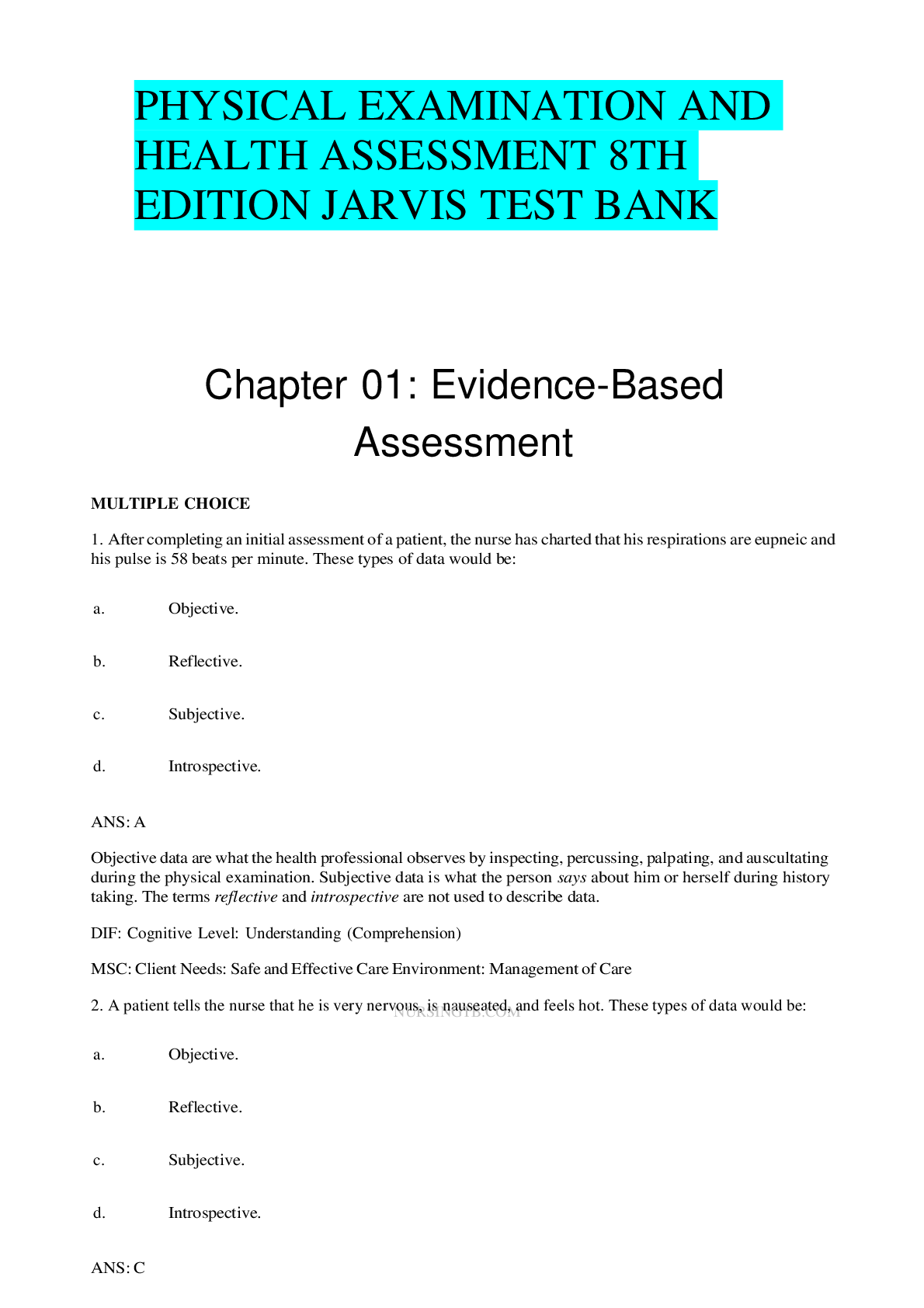
Reviews( 0 )
Document information
Connected school, study & course
About the document
Uploaded On
Sep 13, 2021
Number of pages
477
Written in
Additional information
This document has been written for:
Uploaded
Sep 13, 2021
Downloads
0
Views
65

